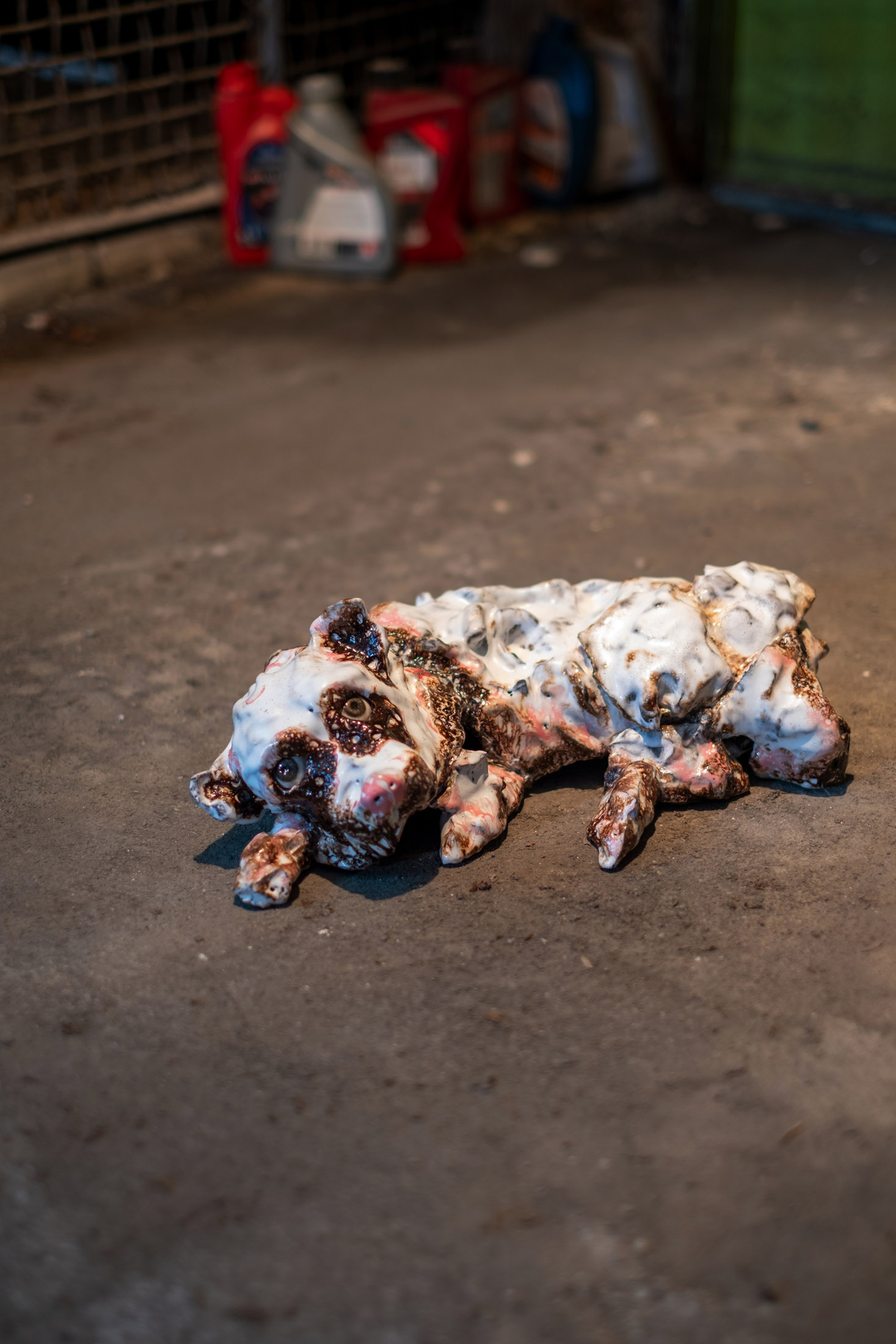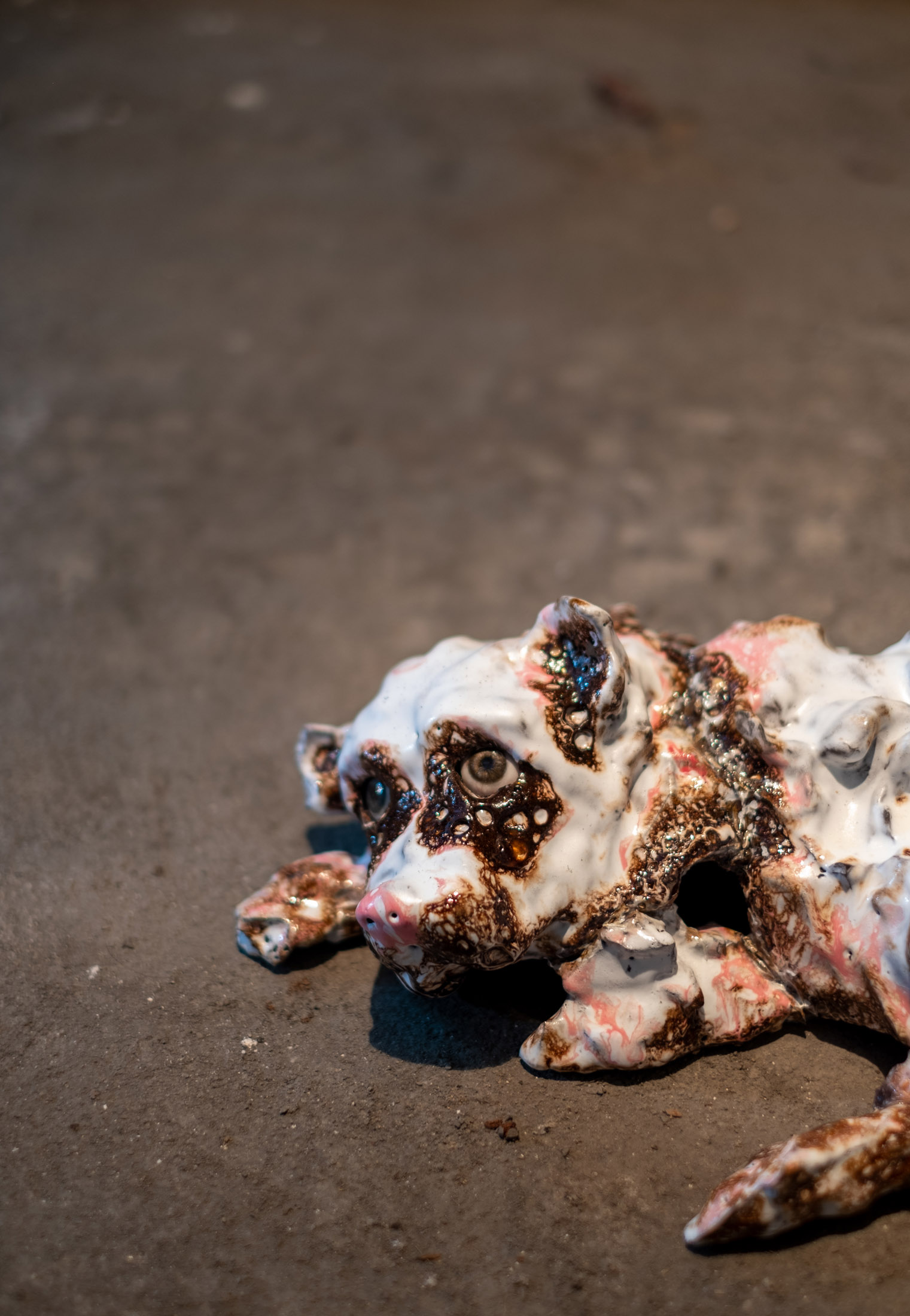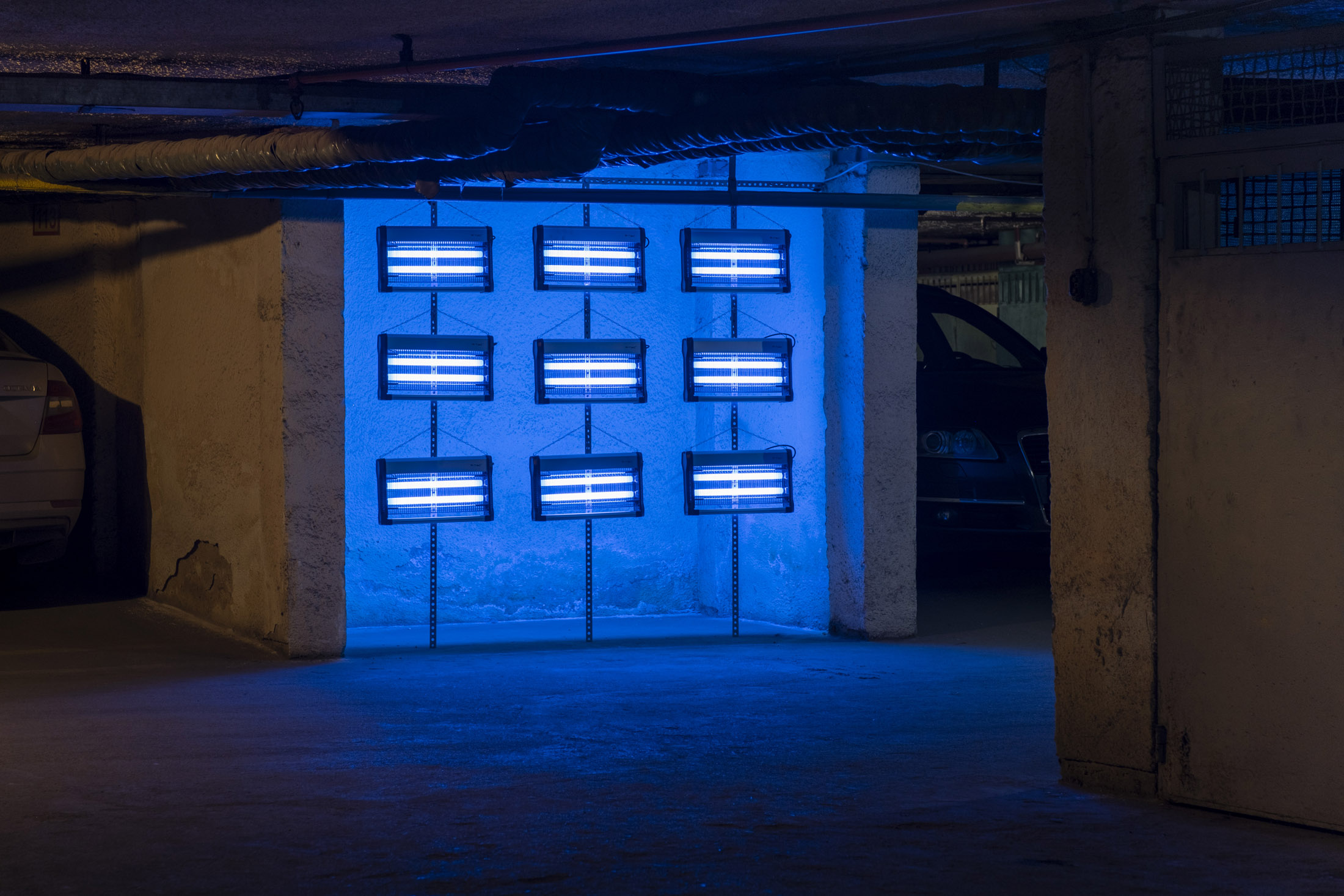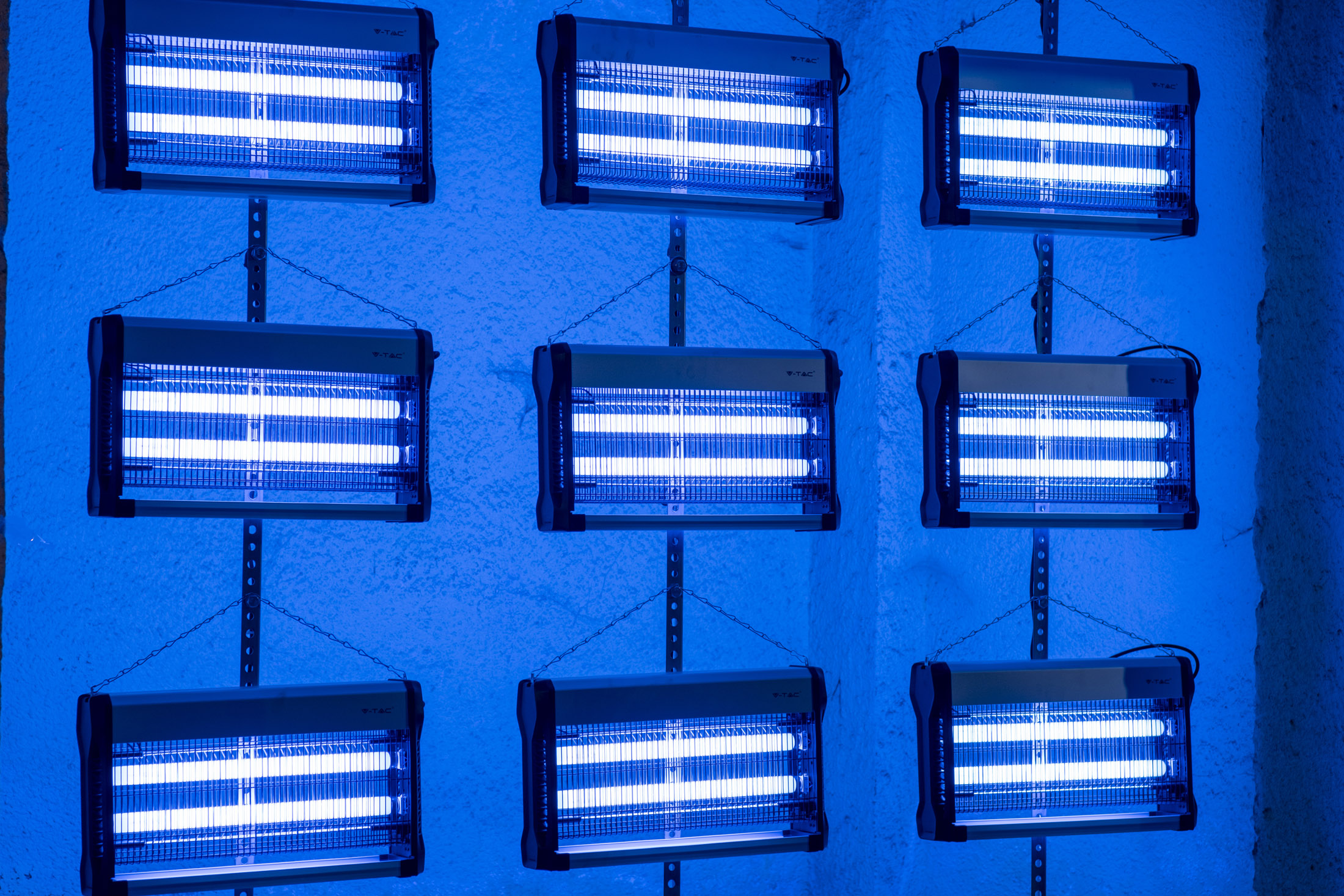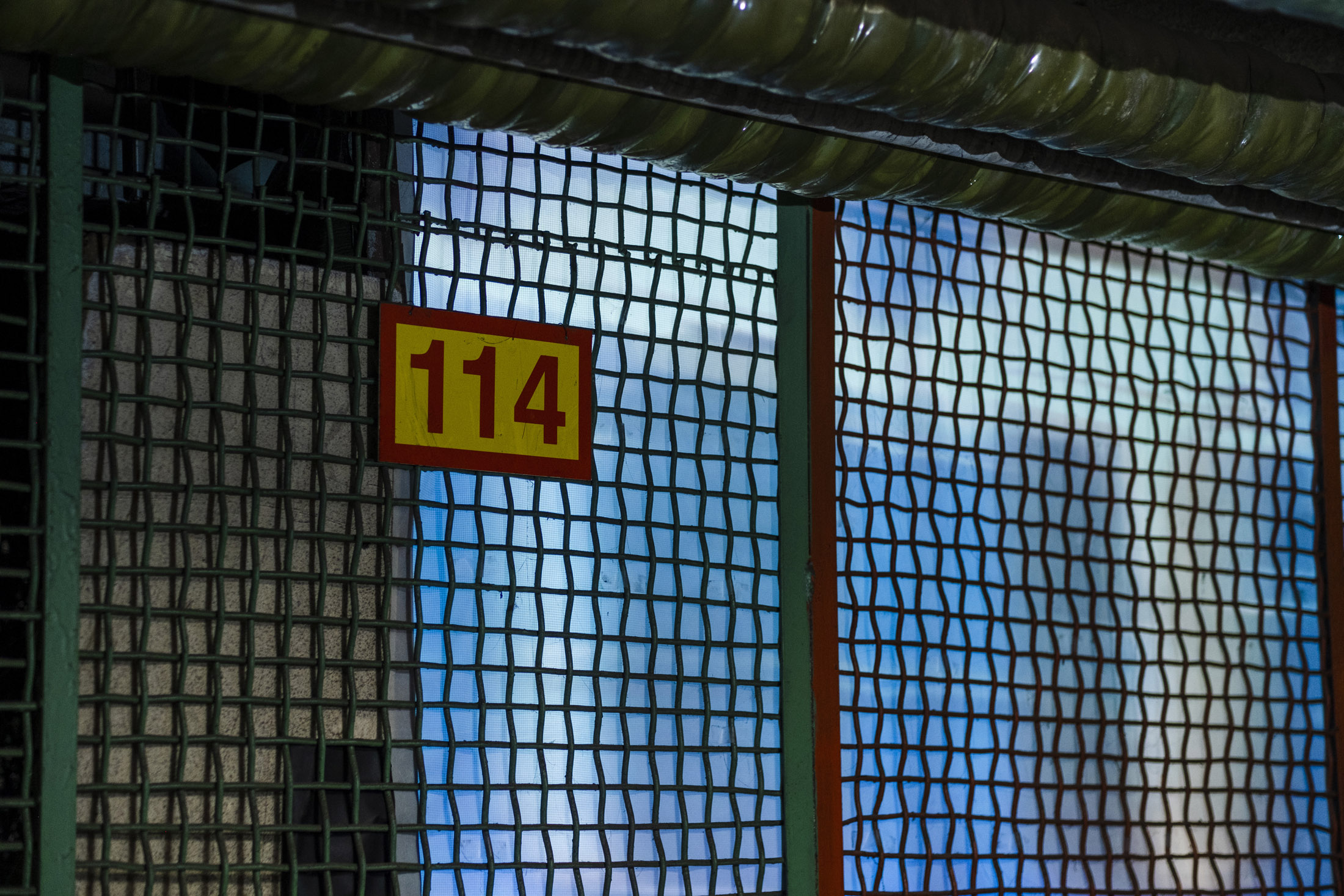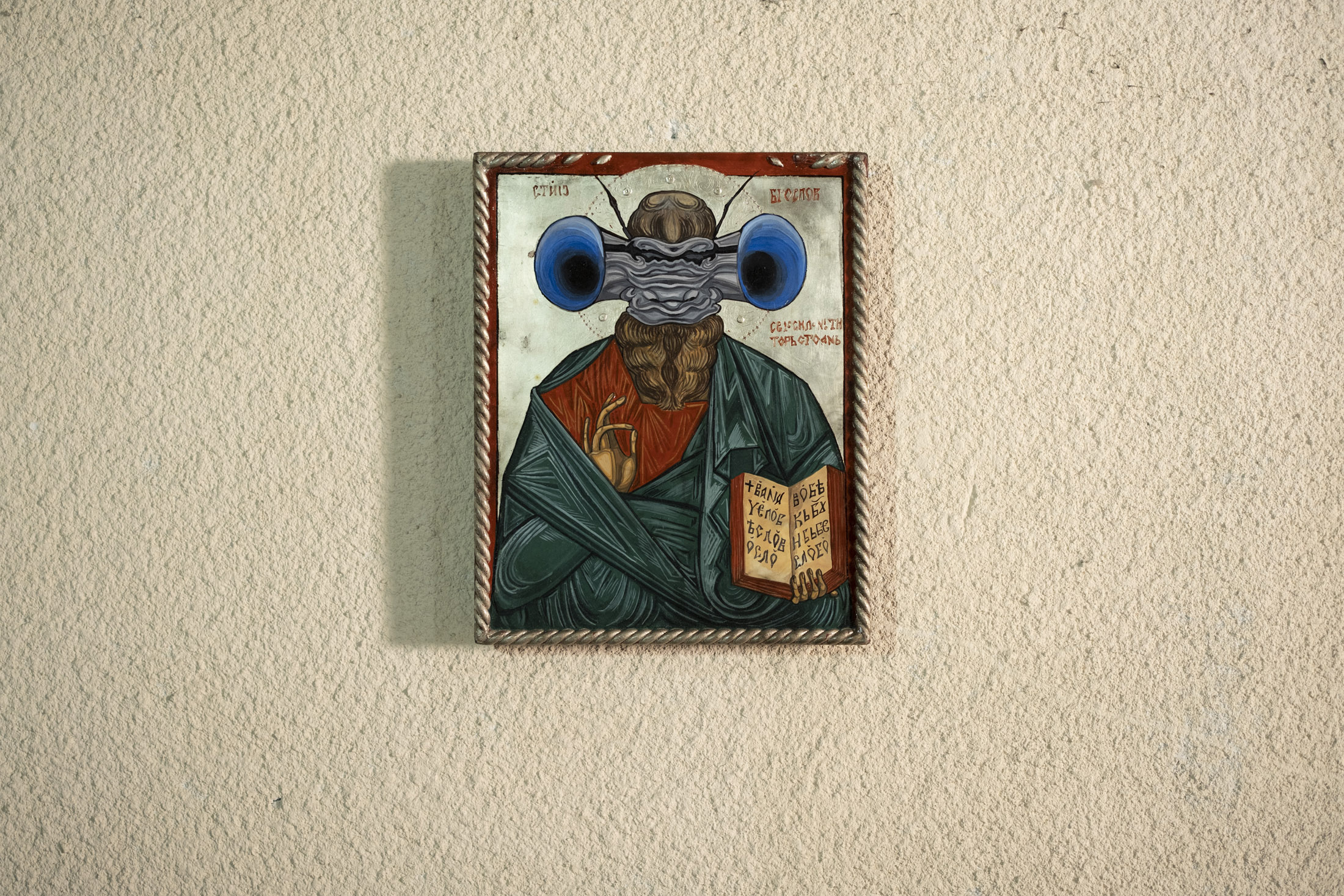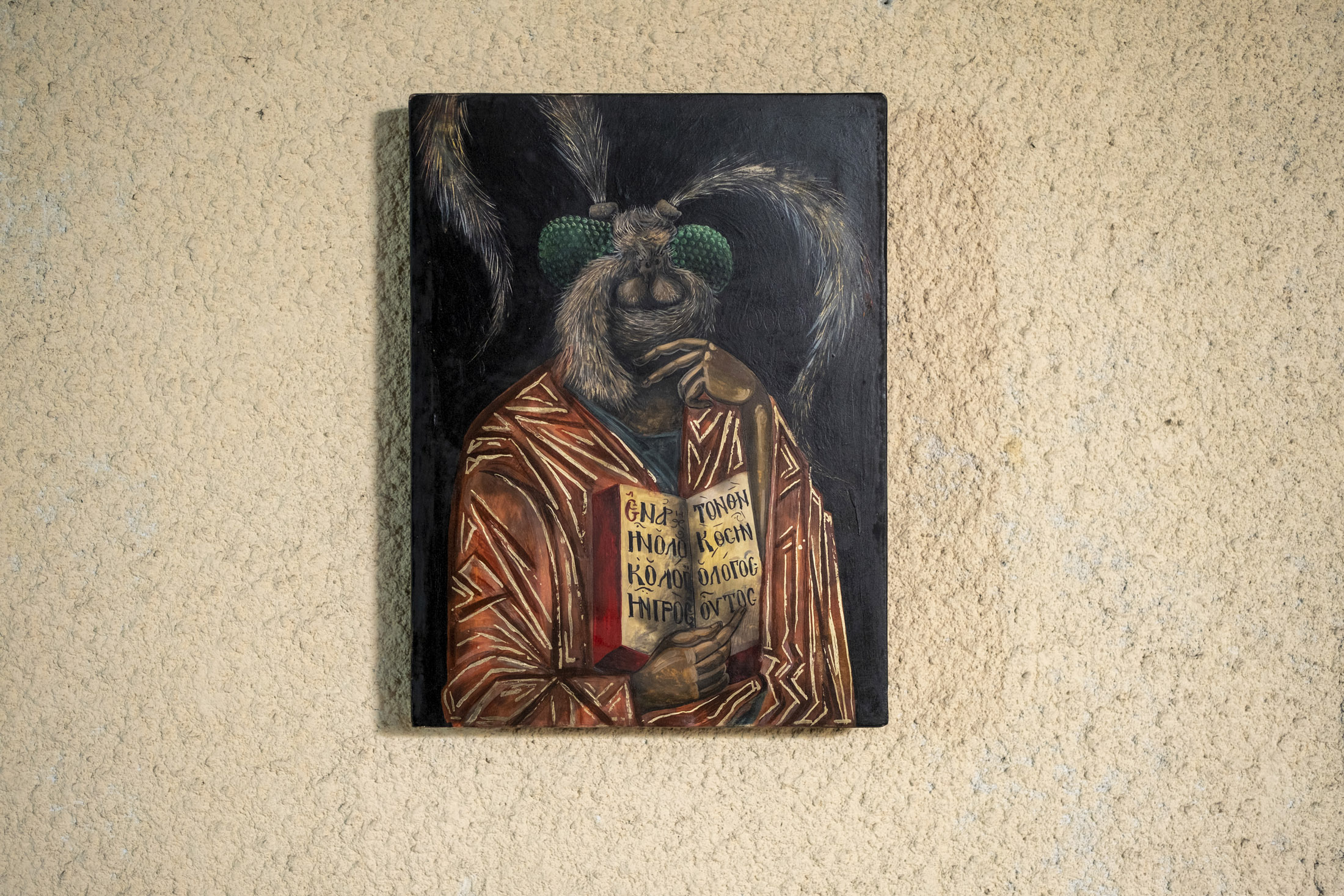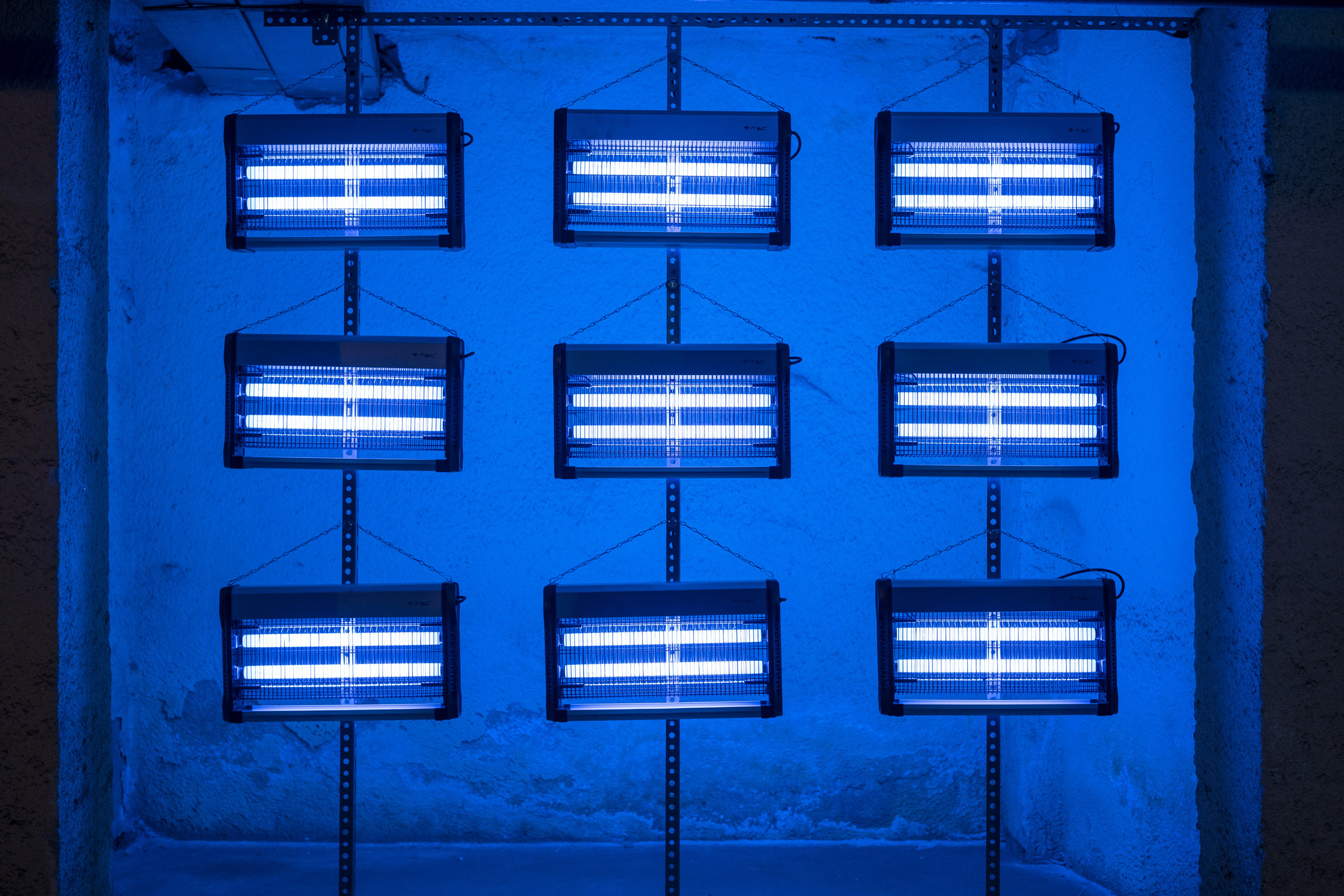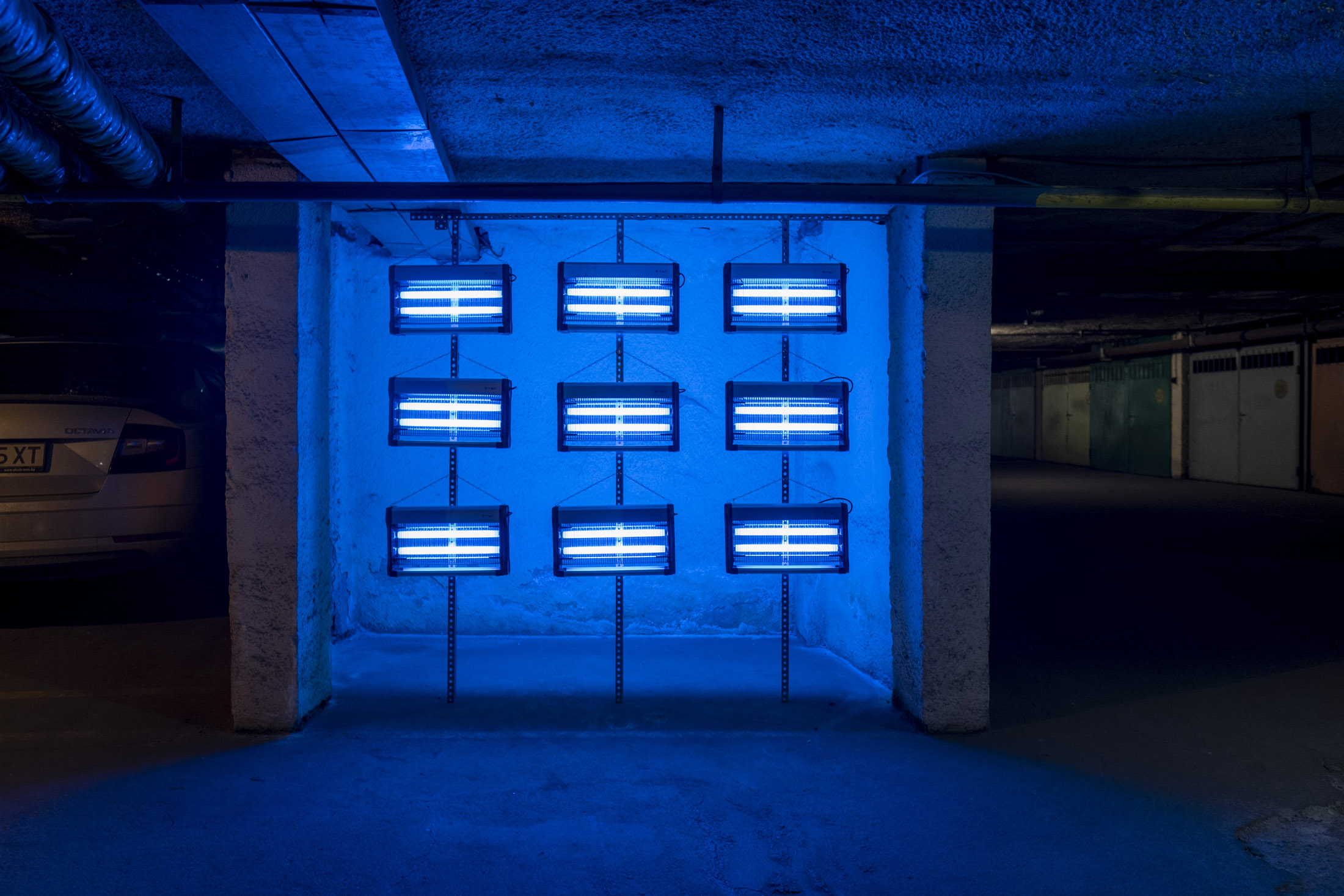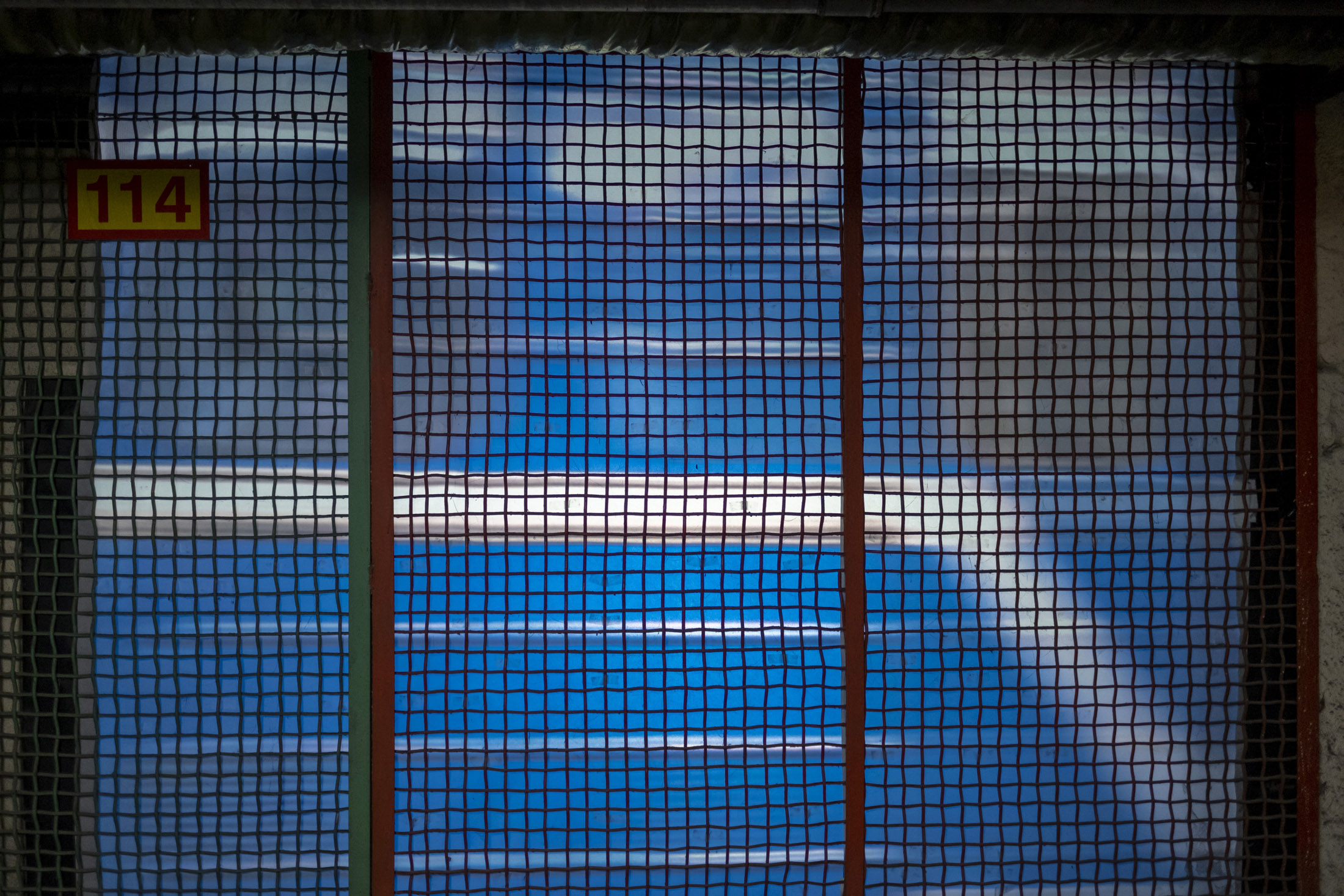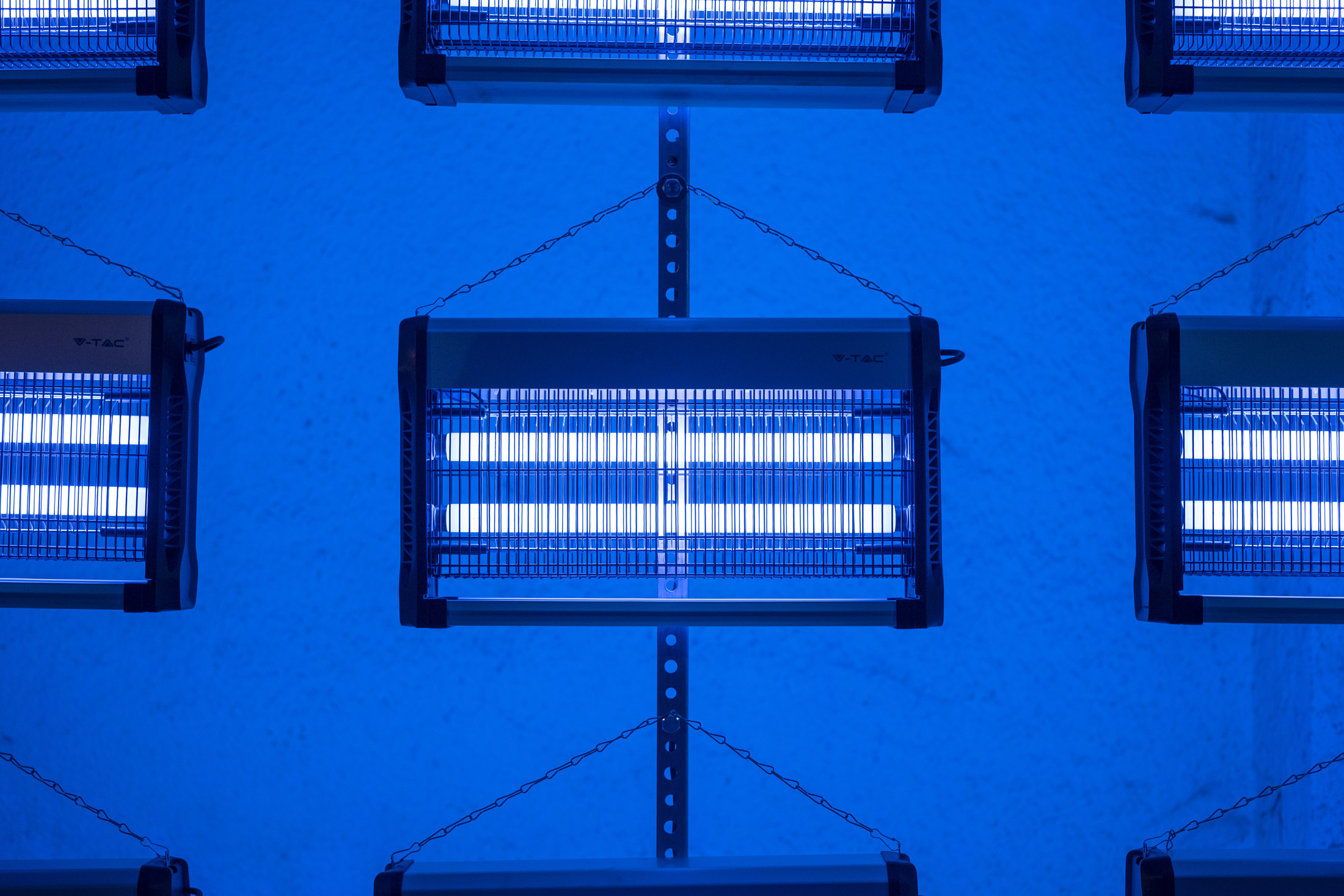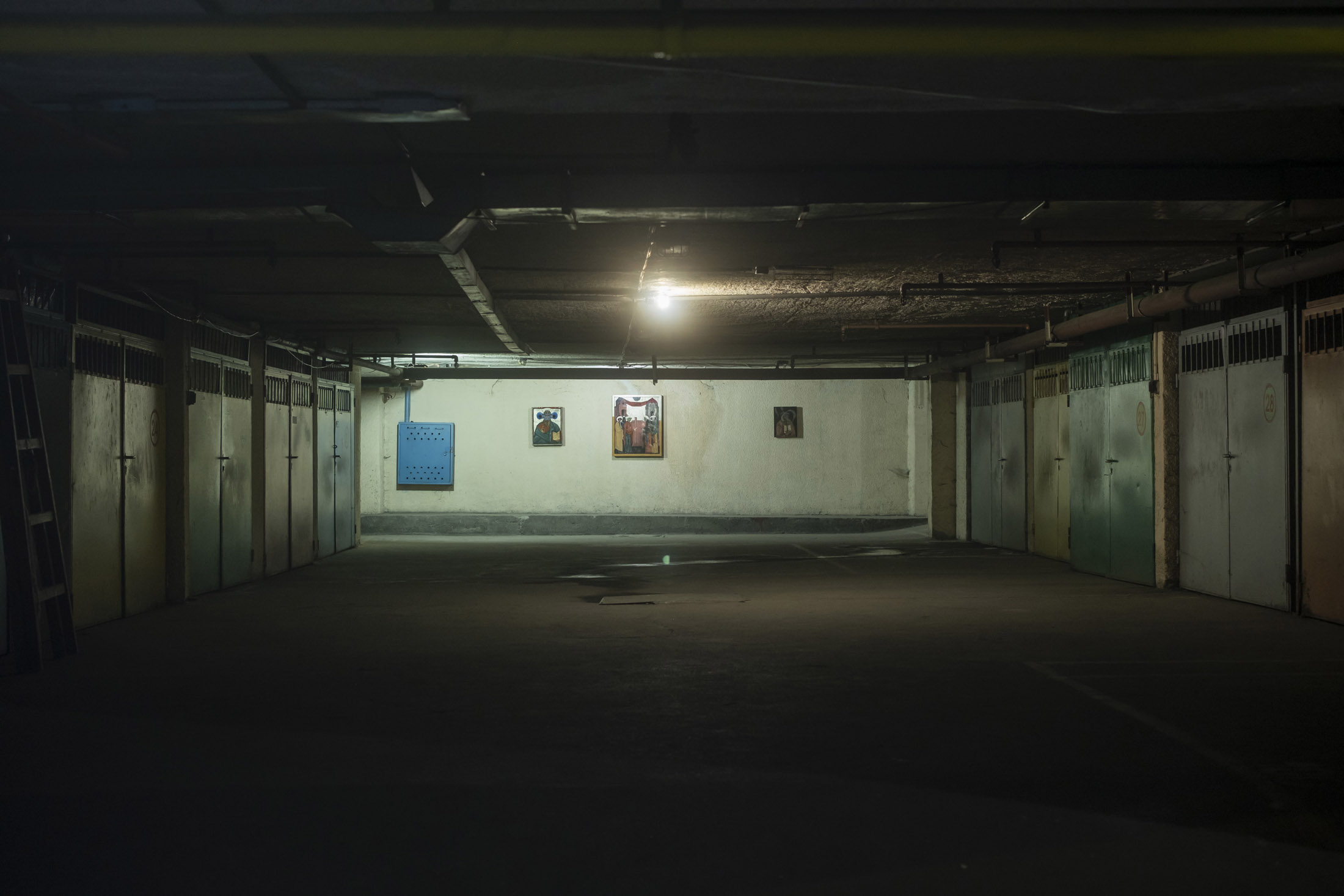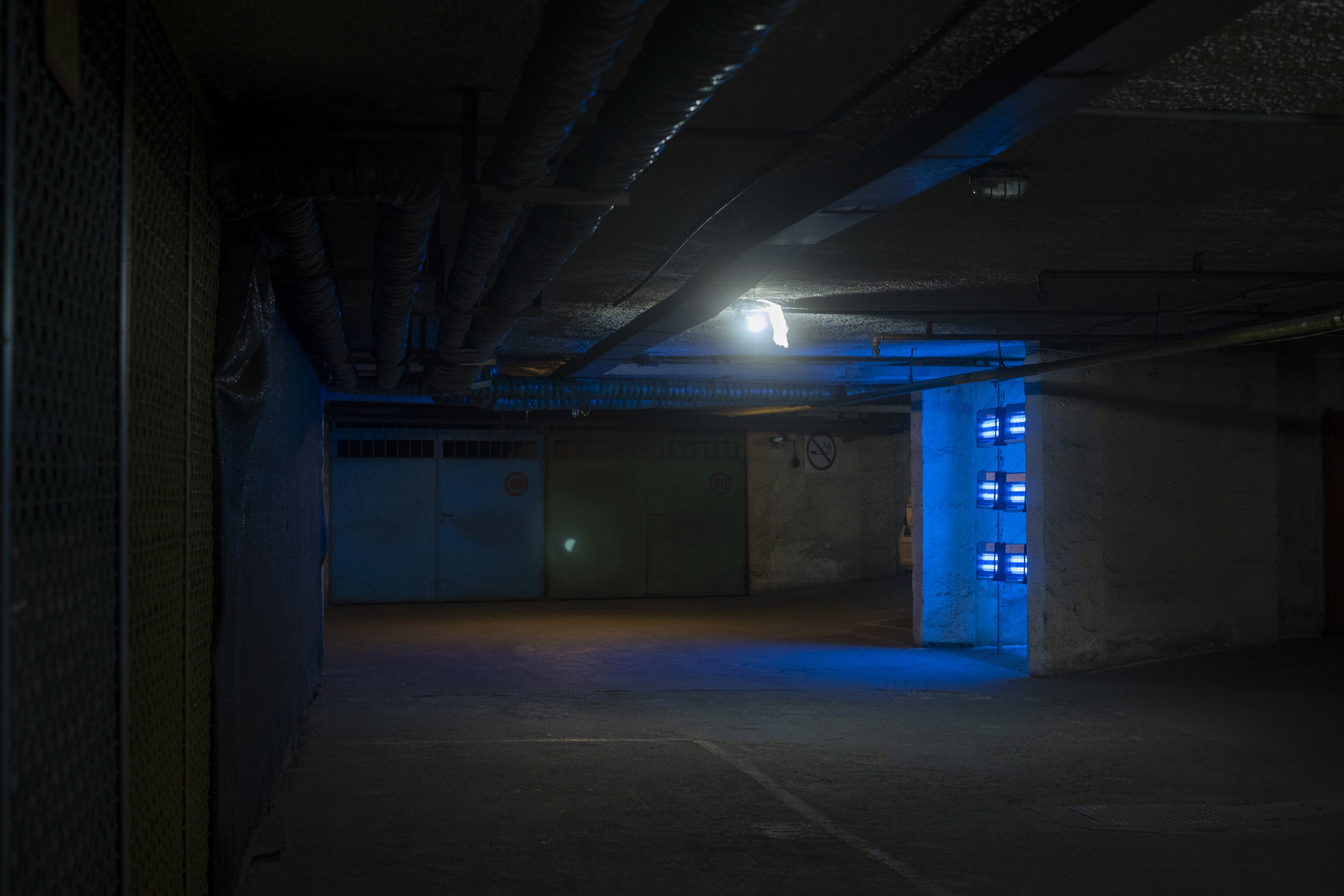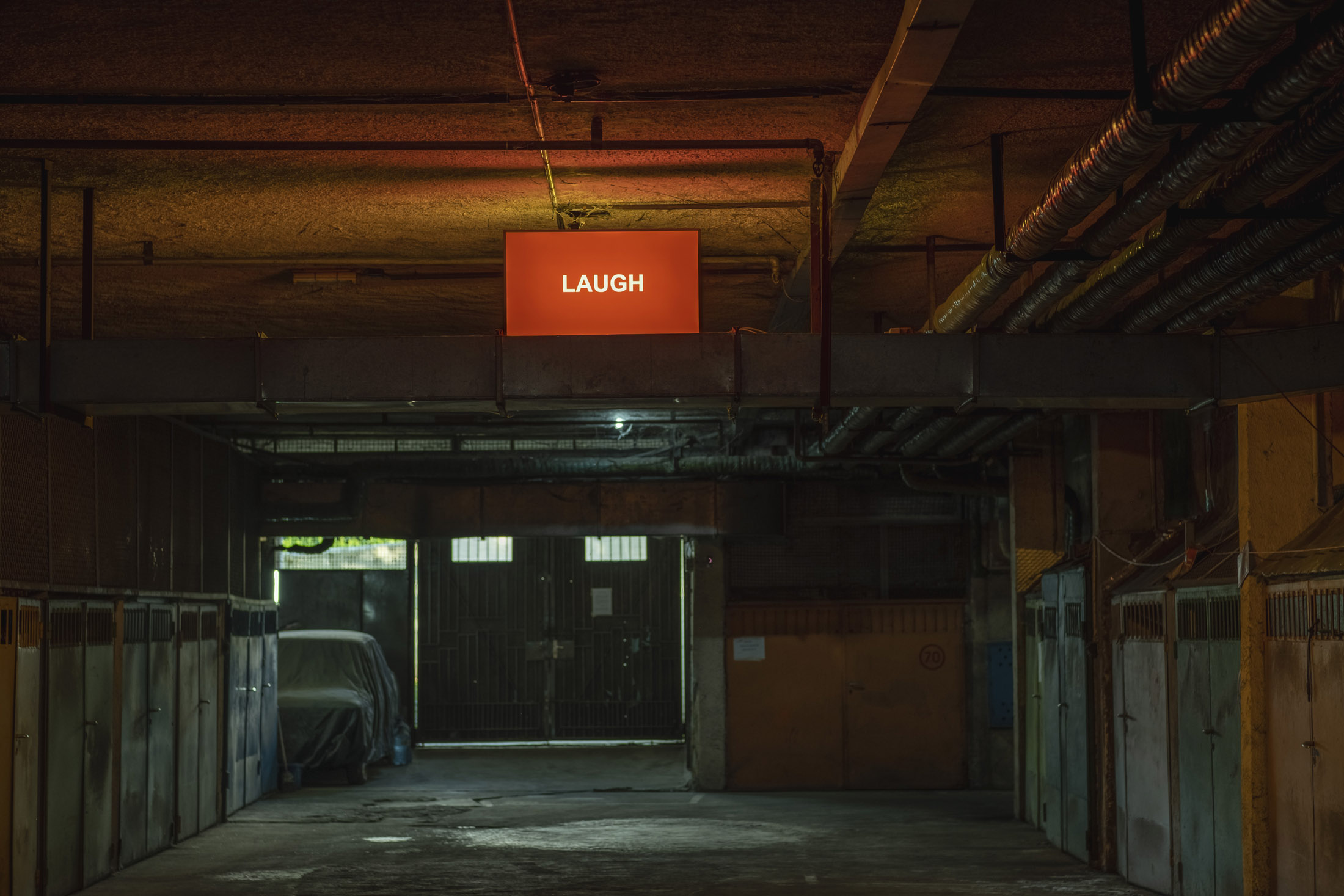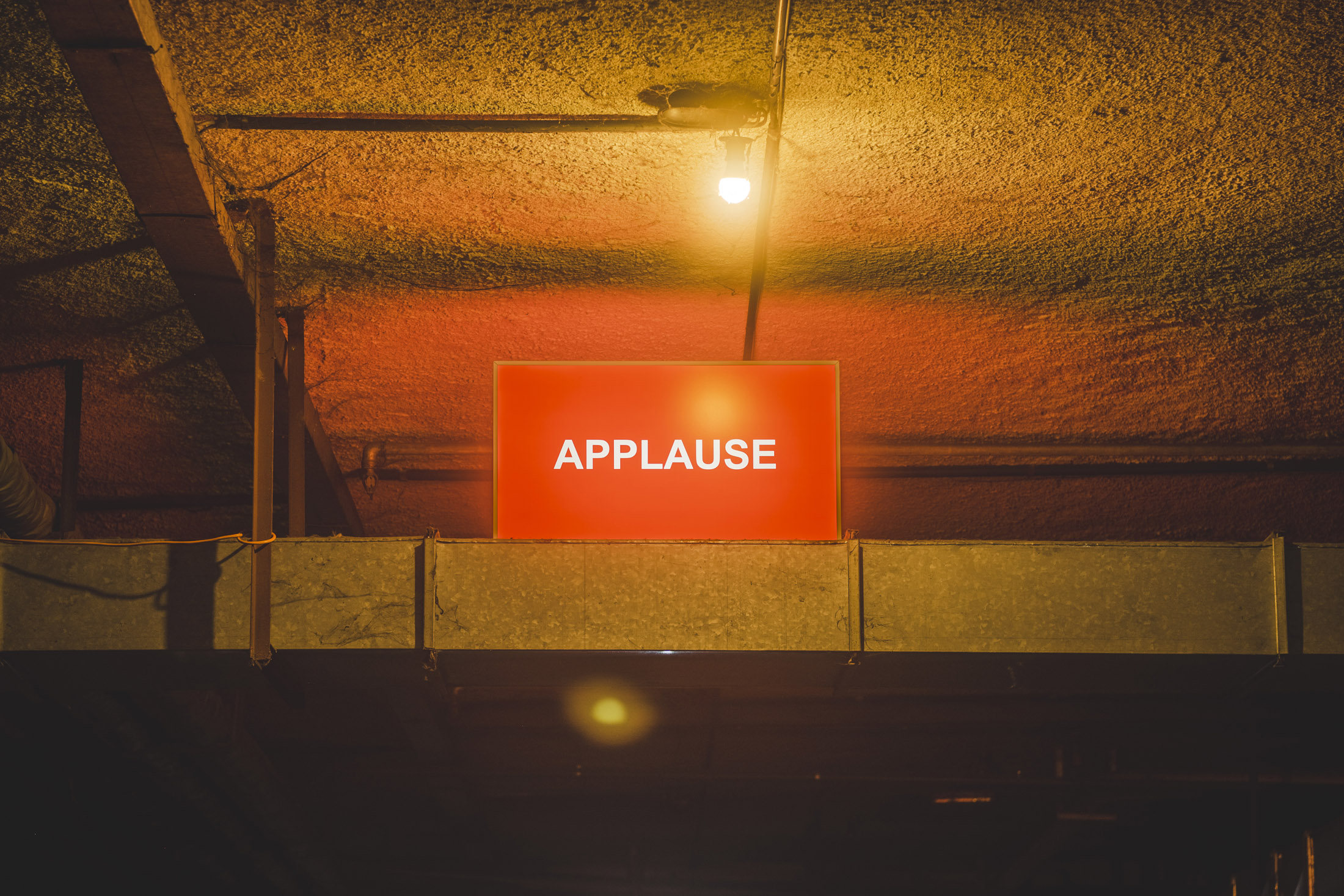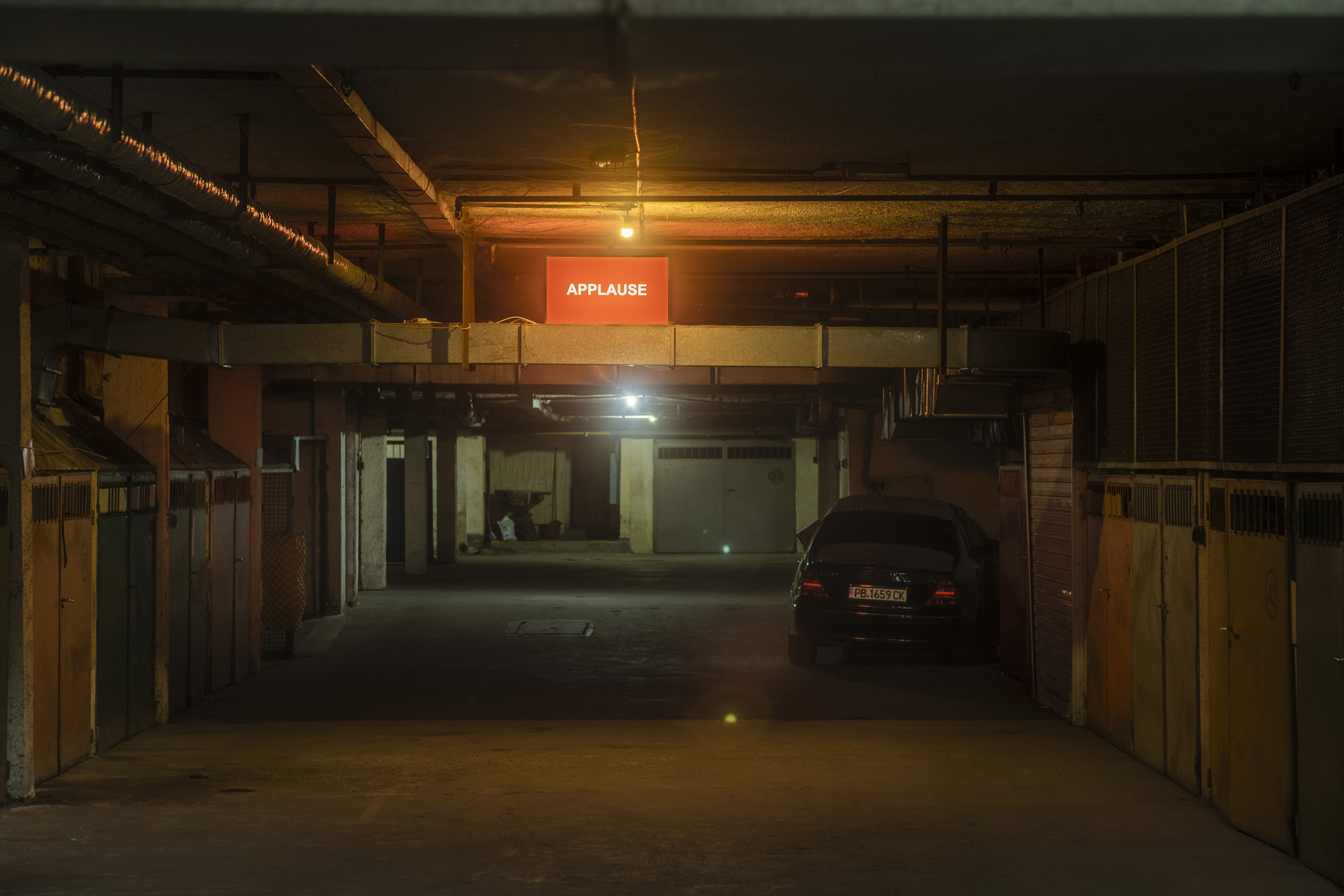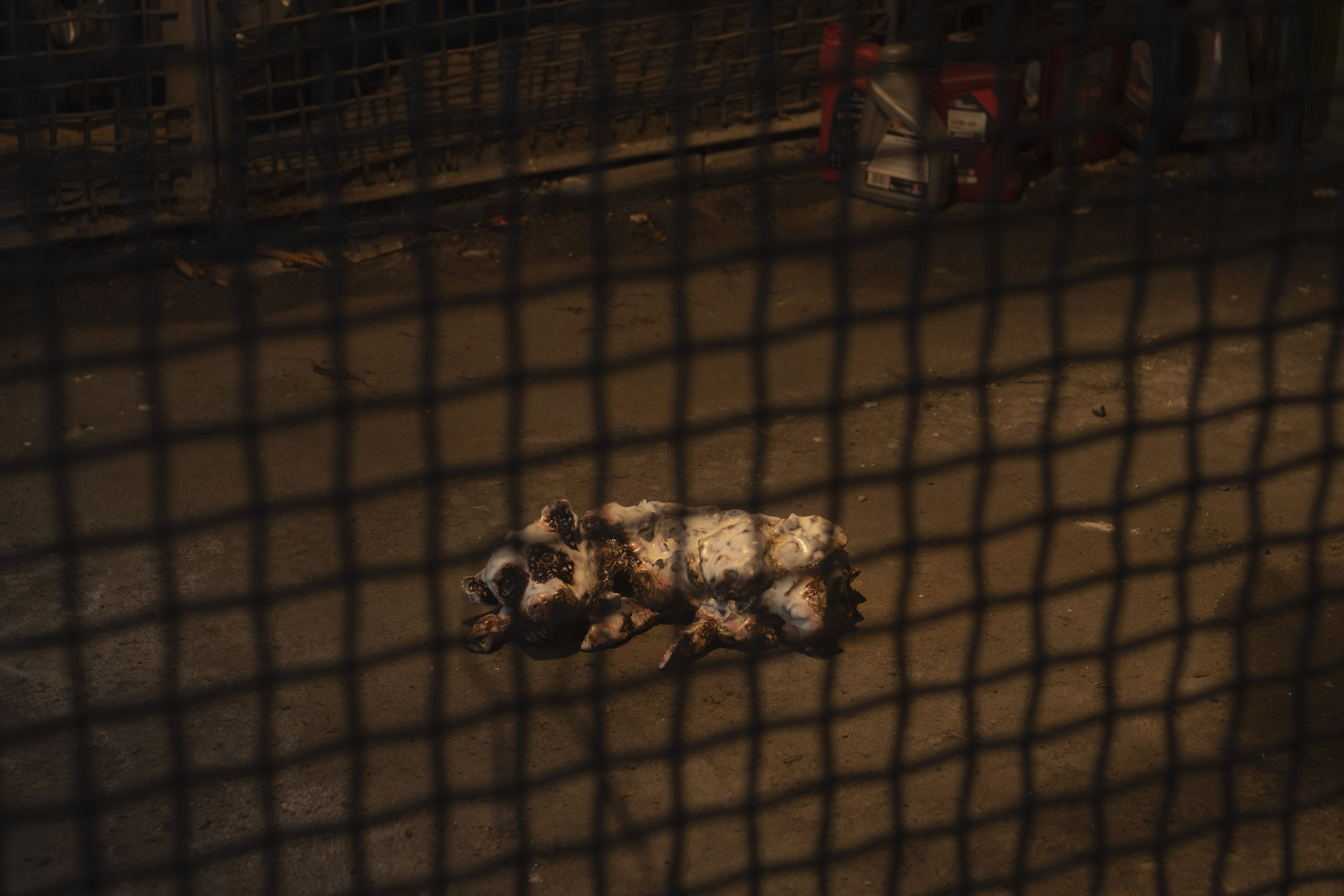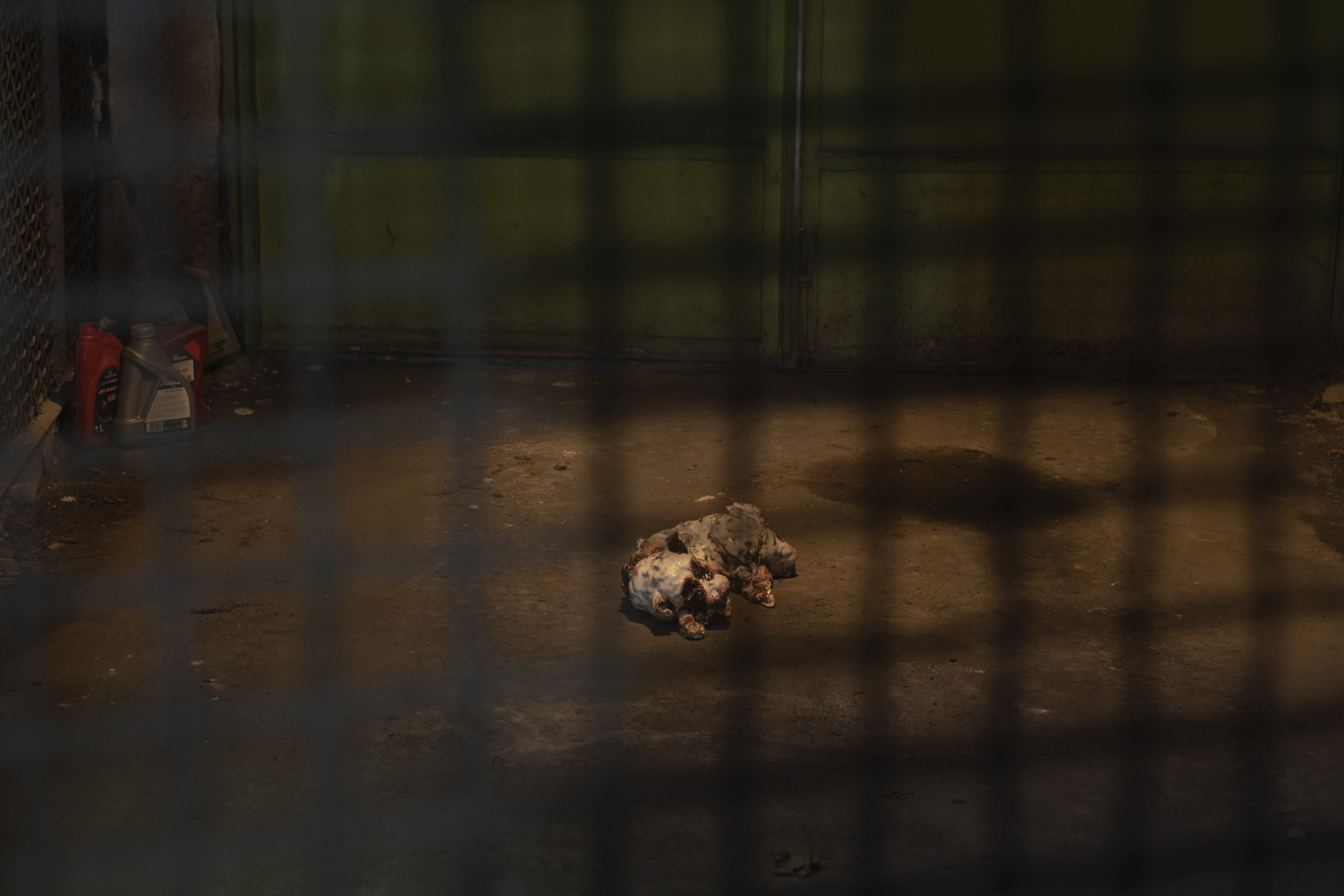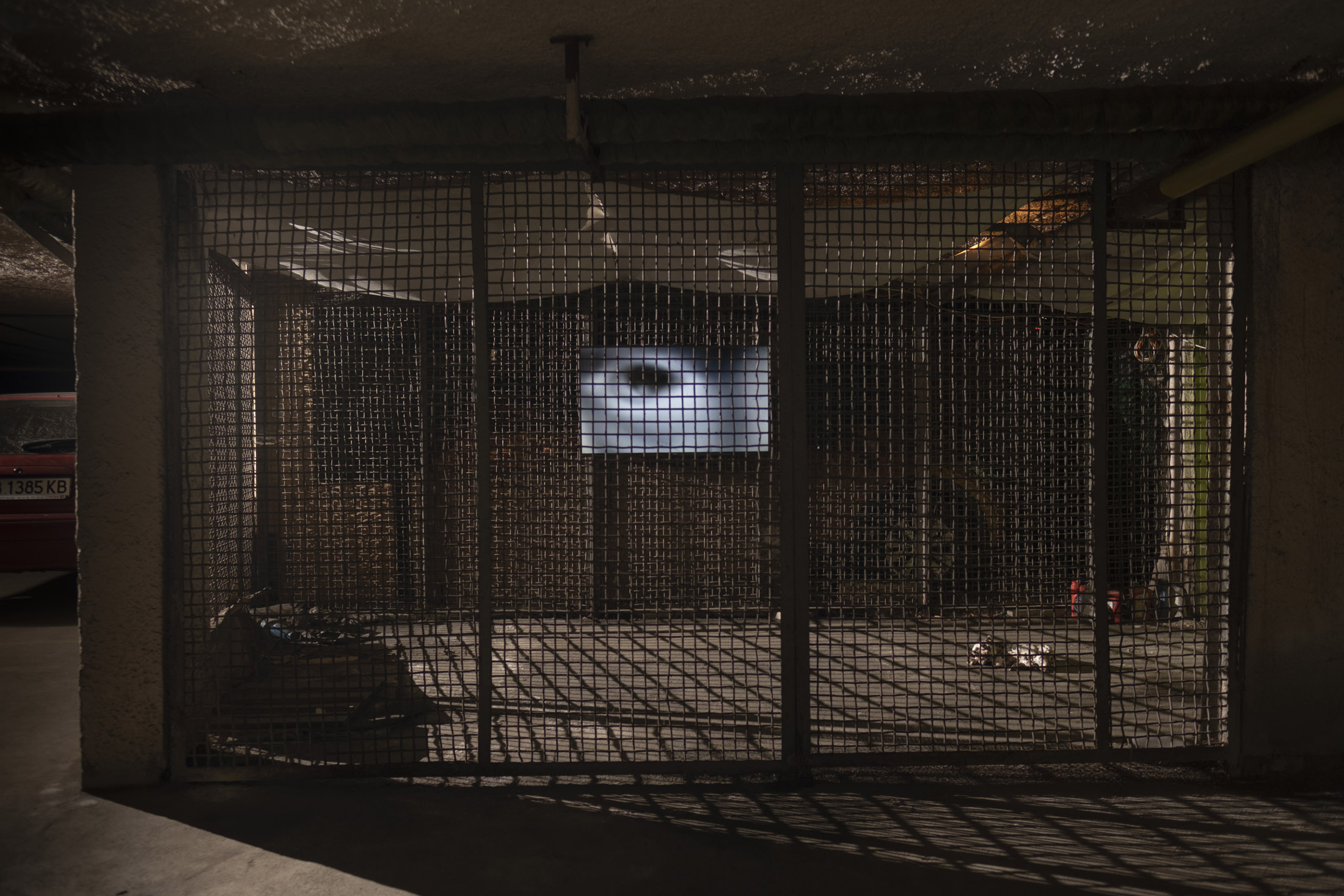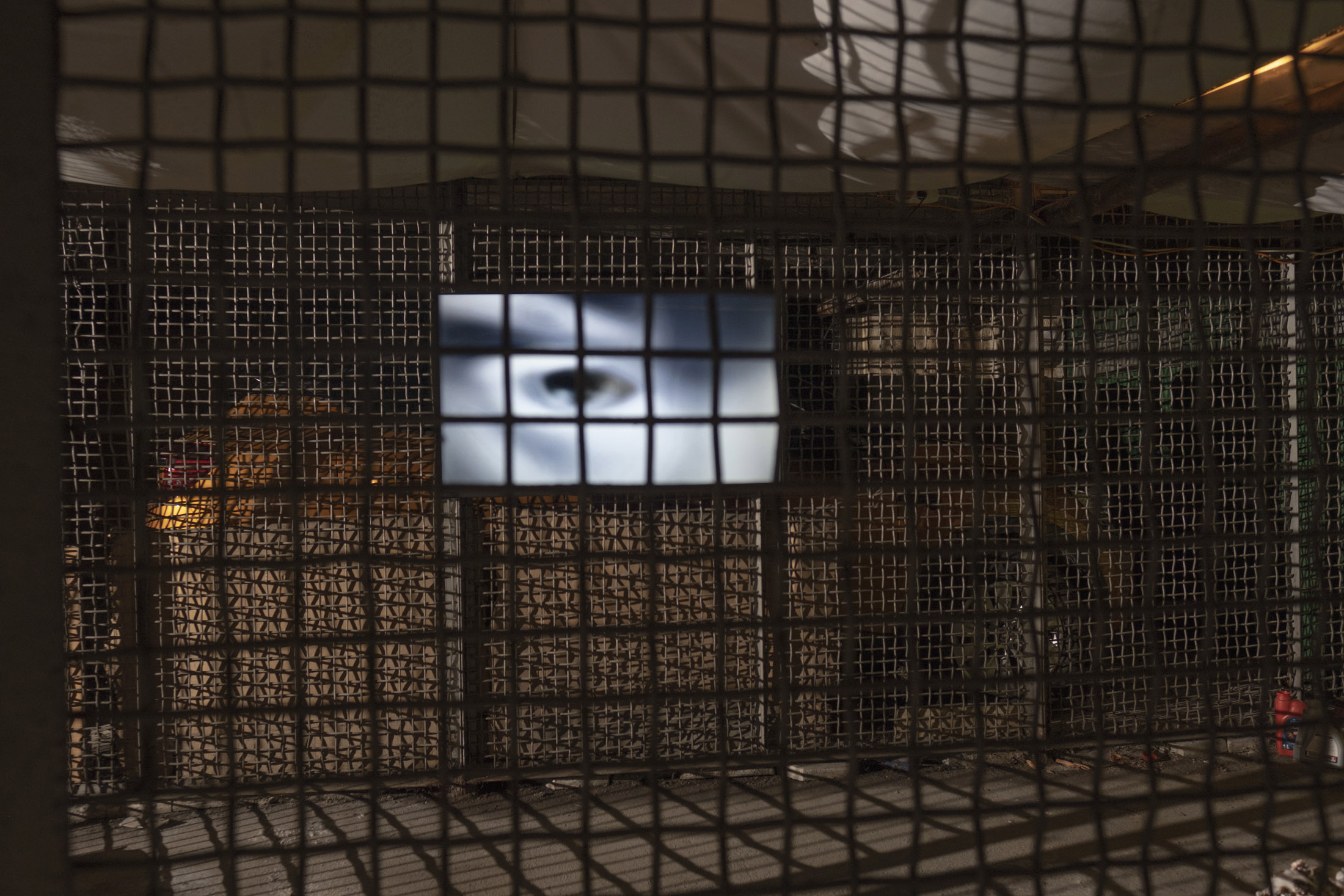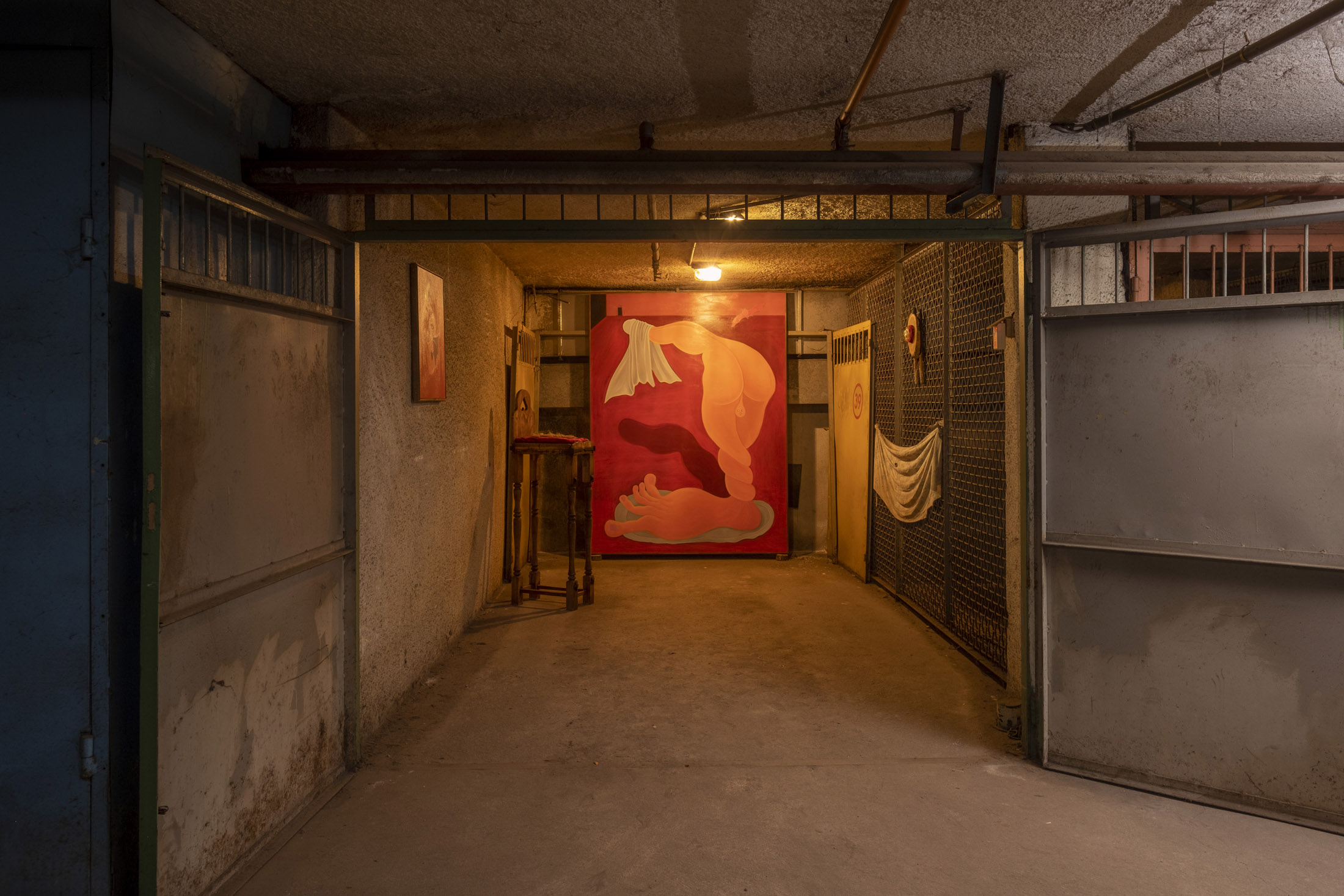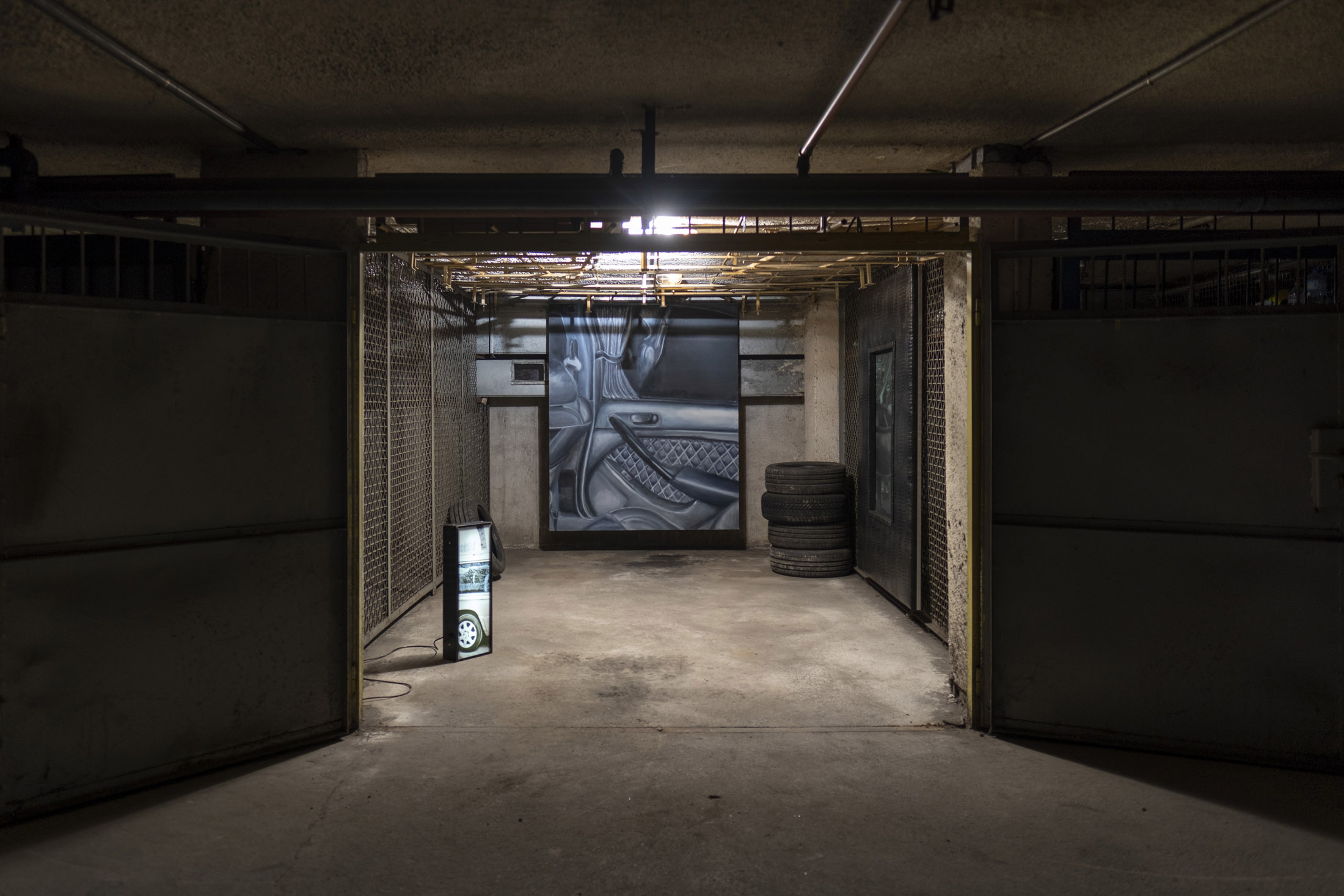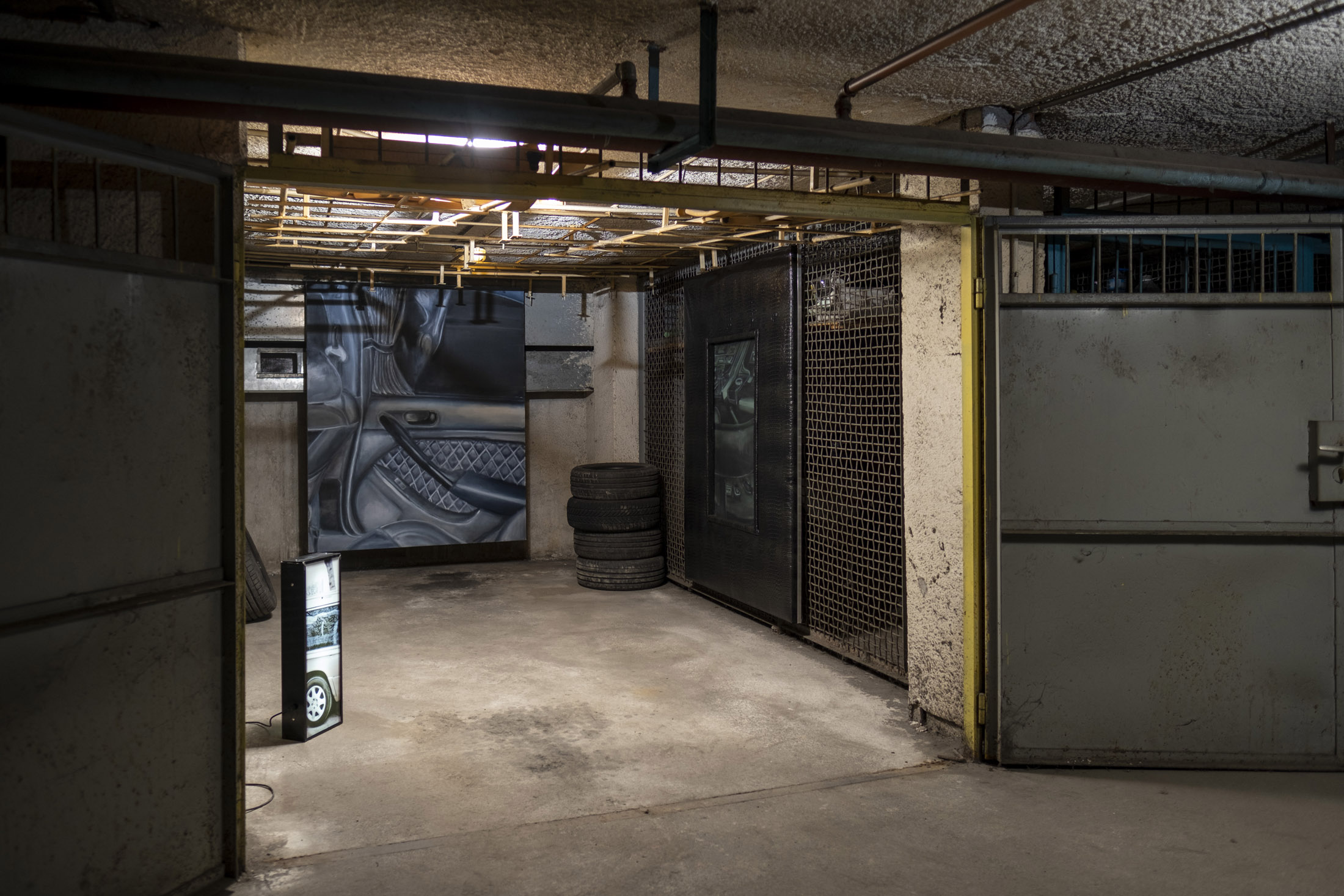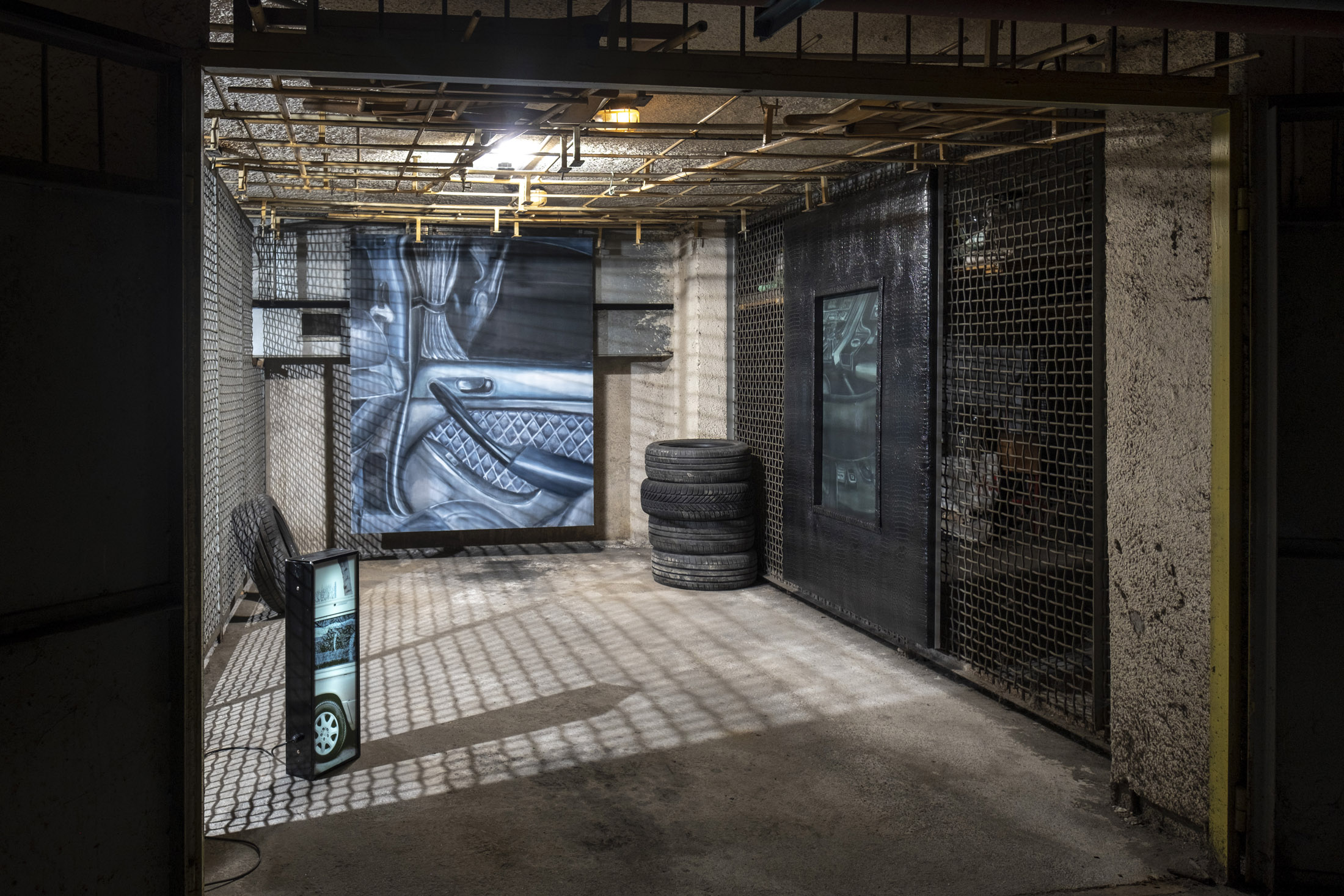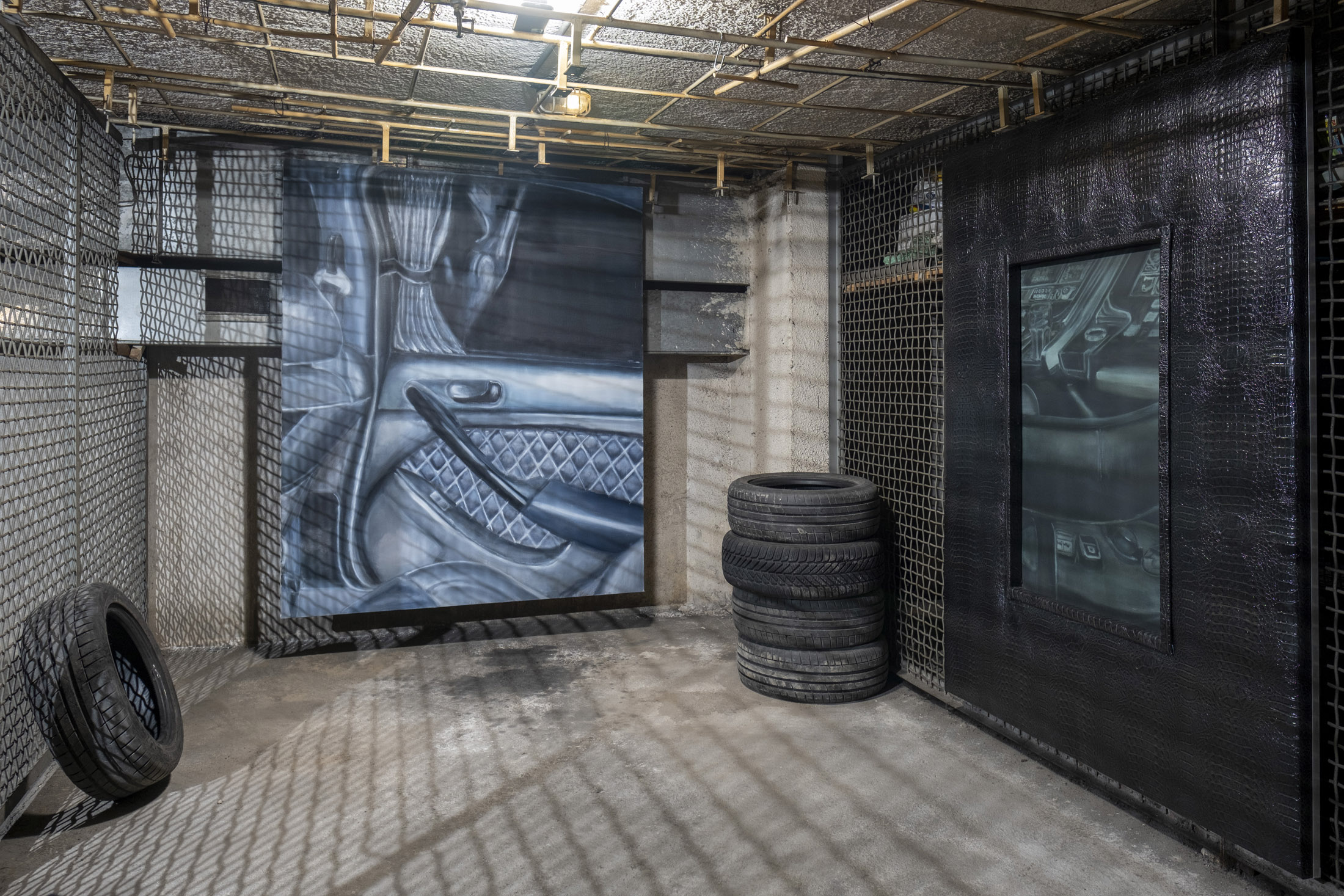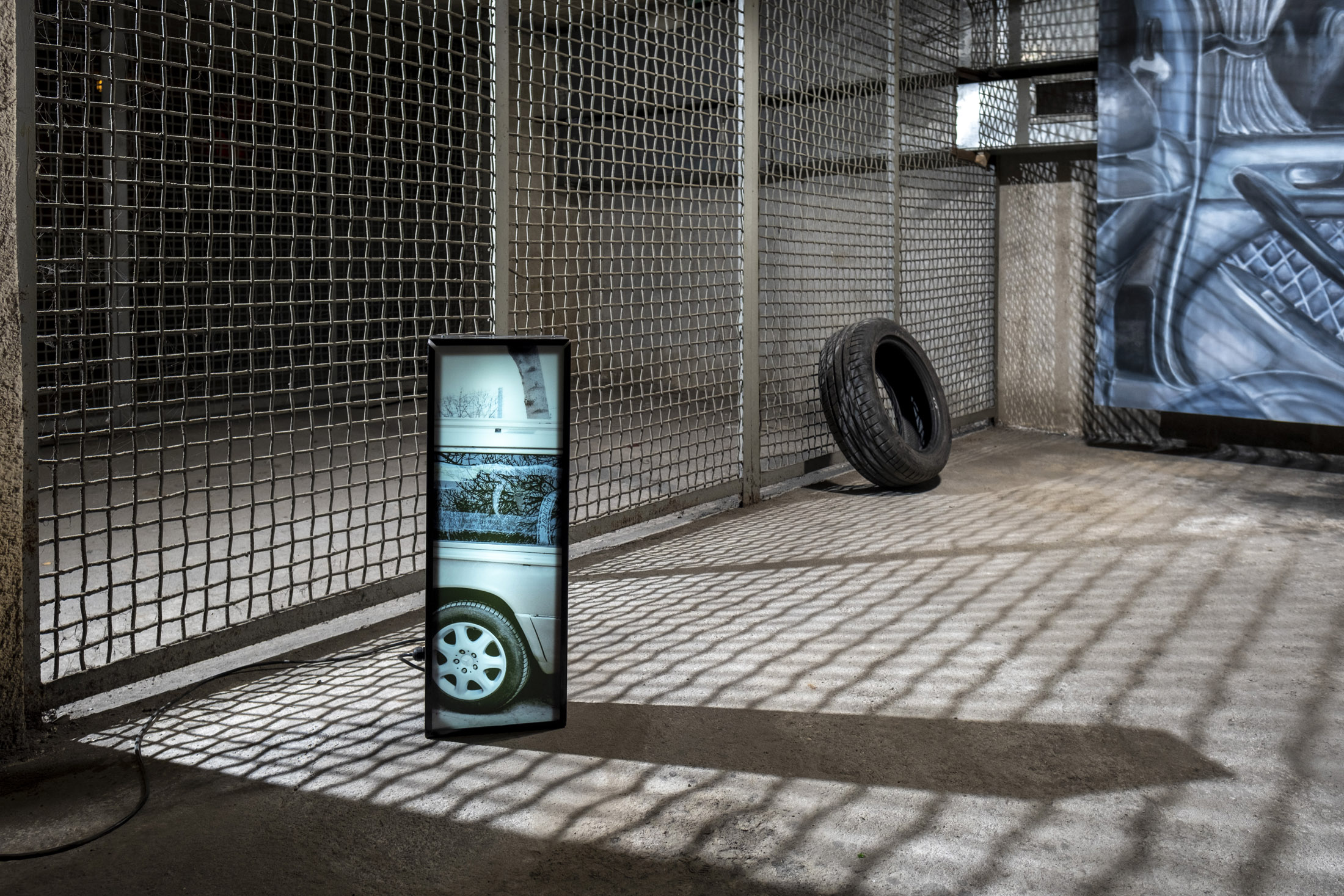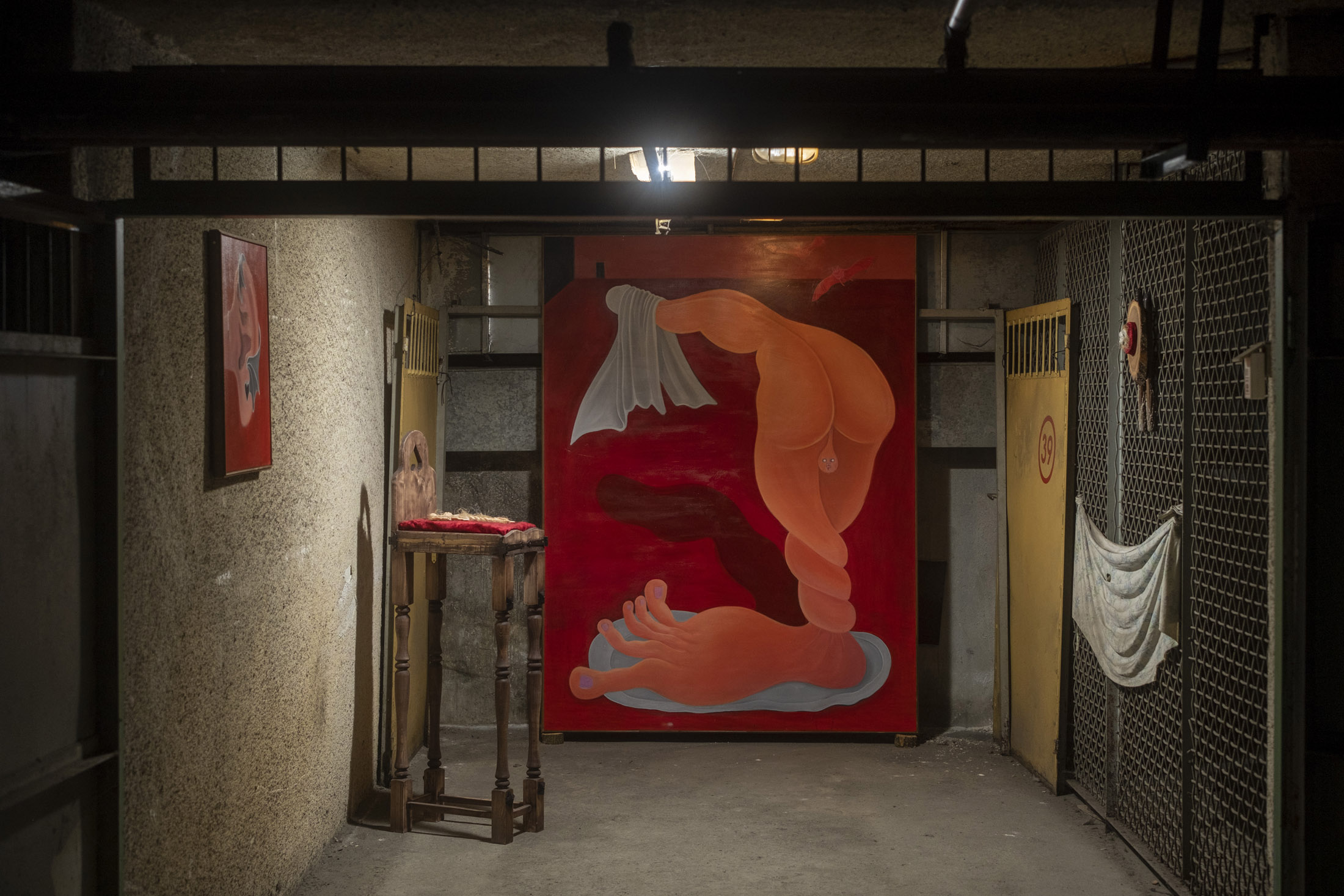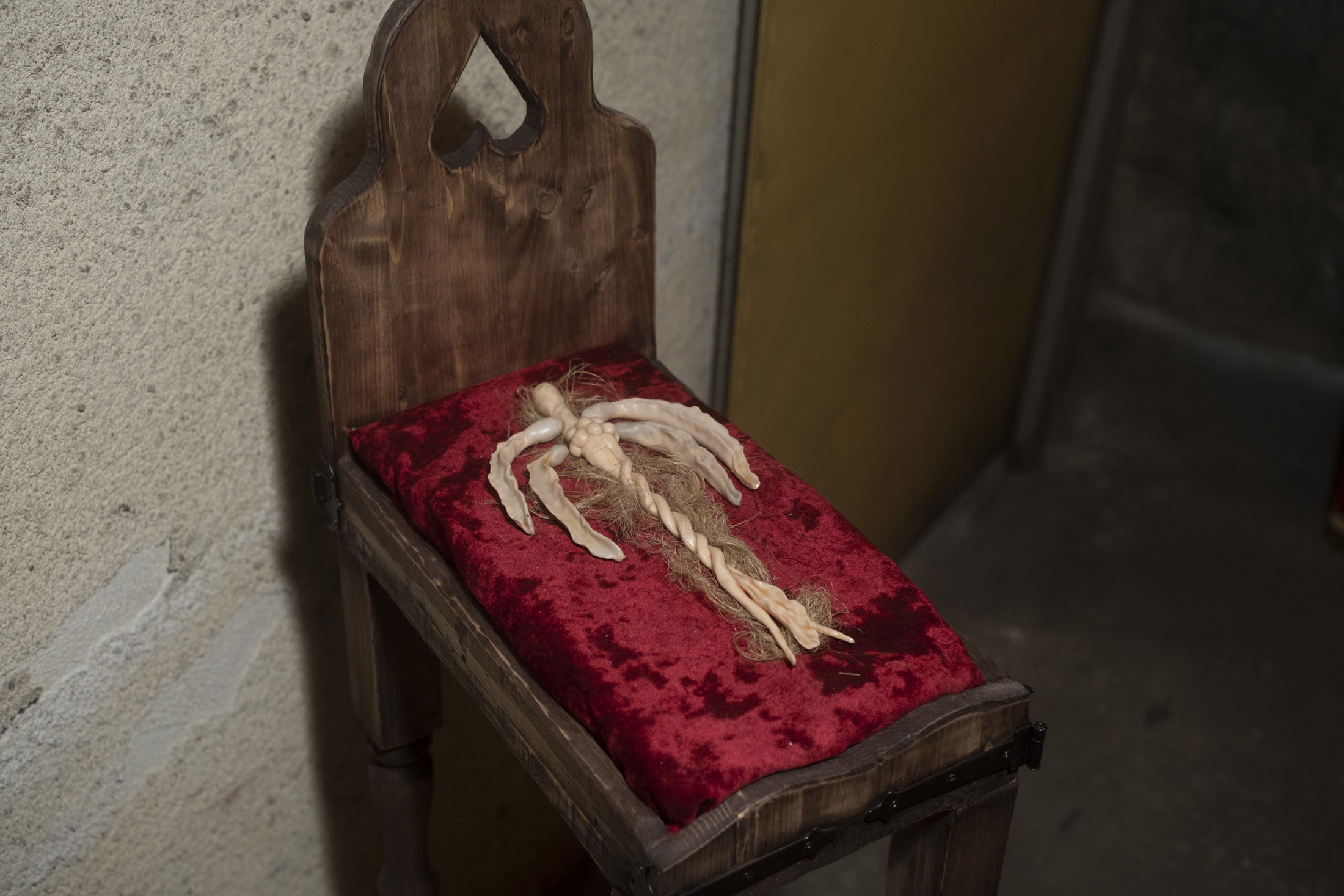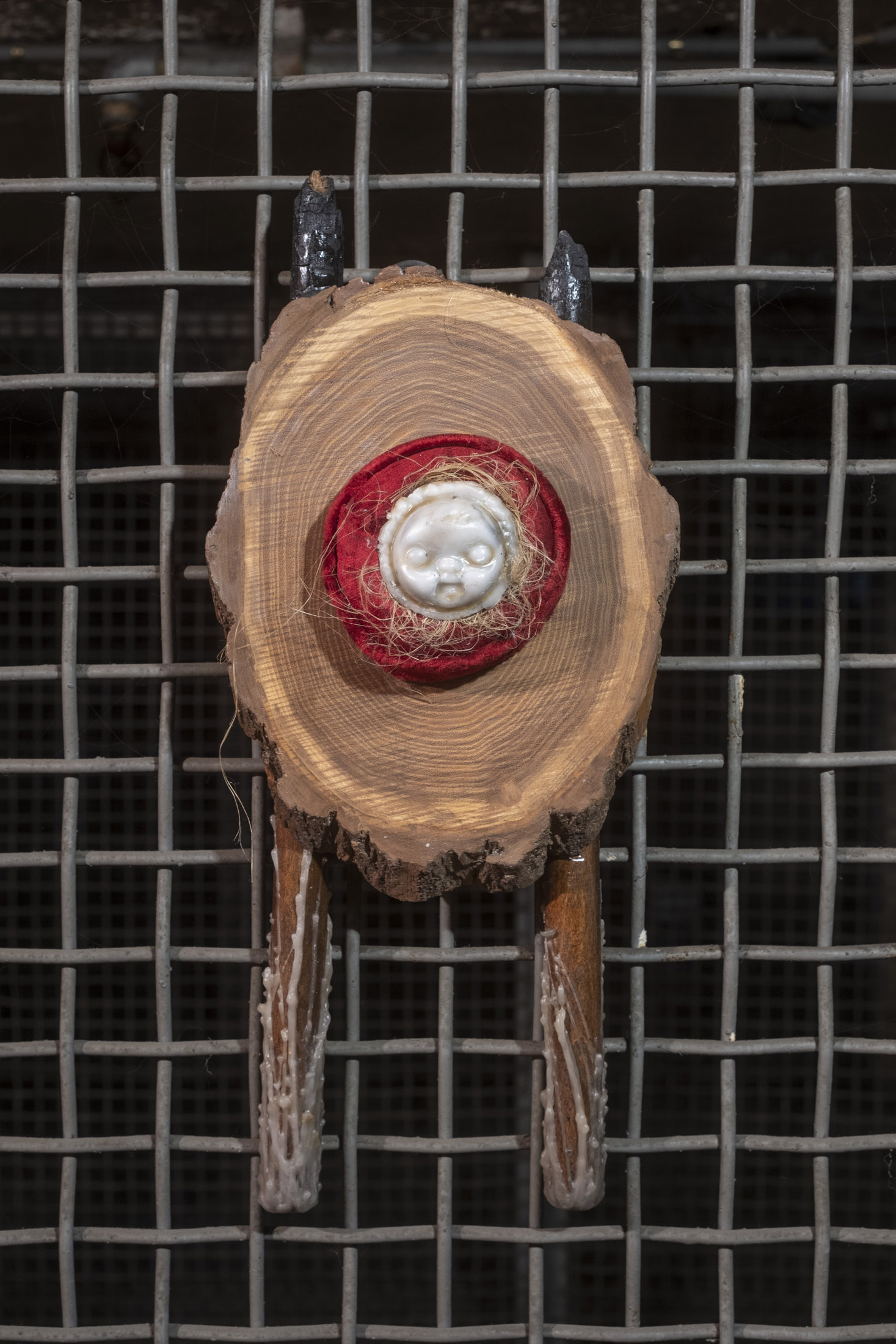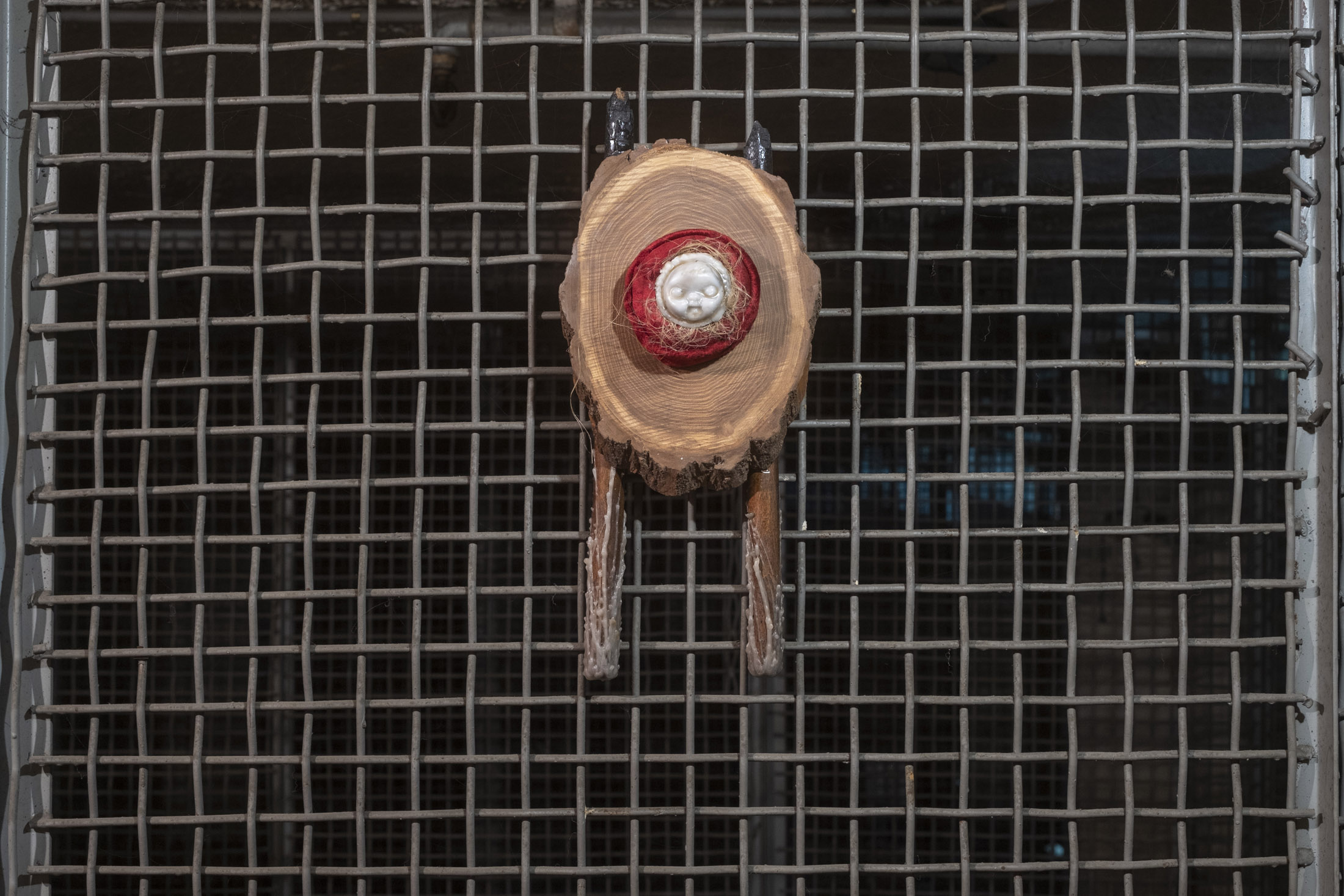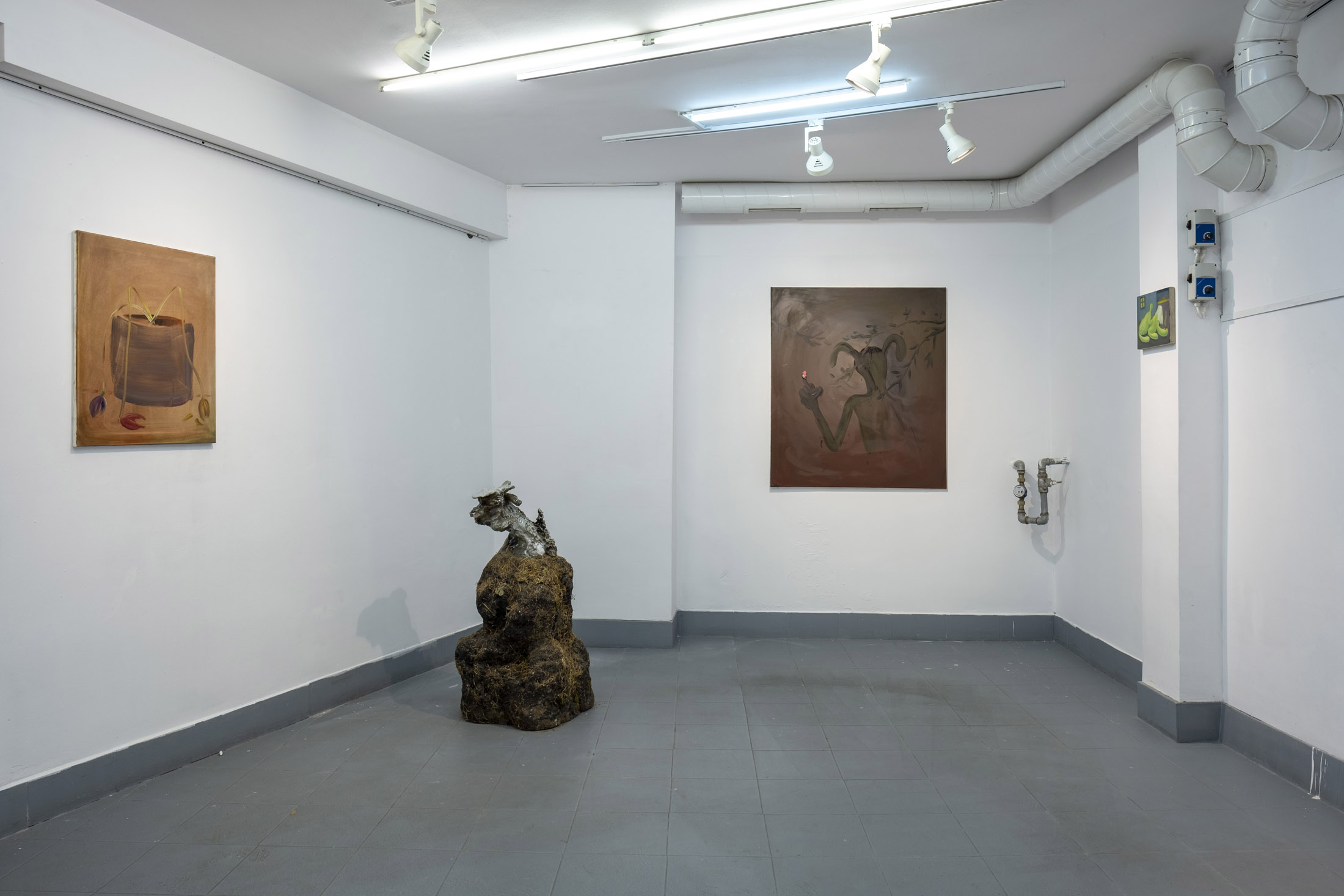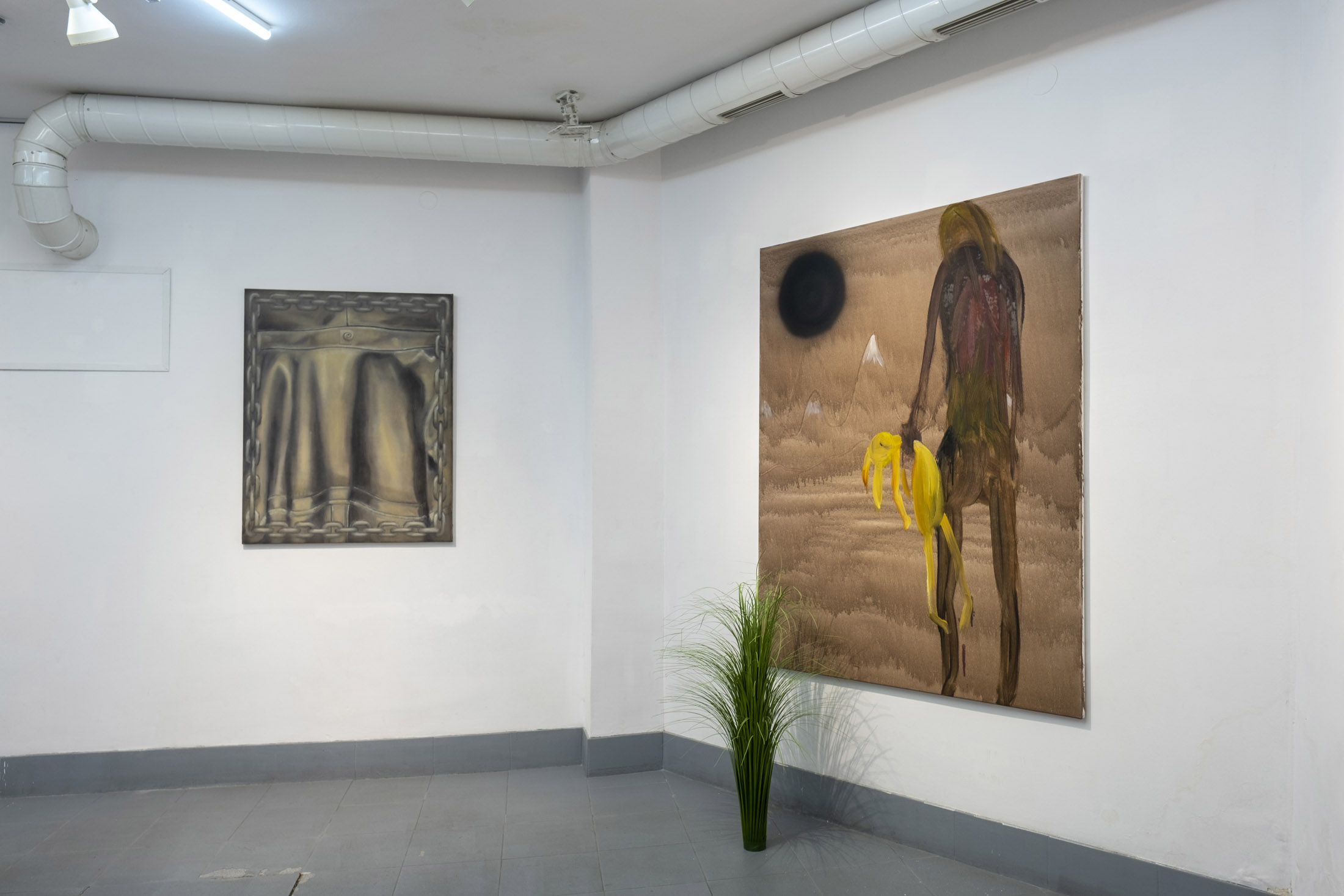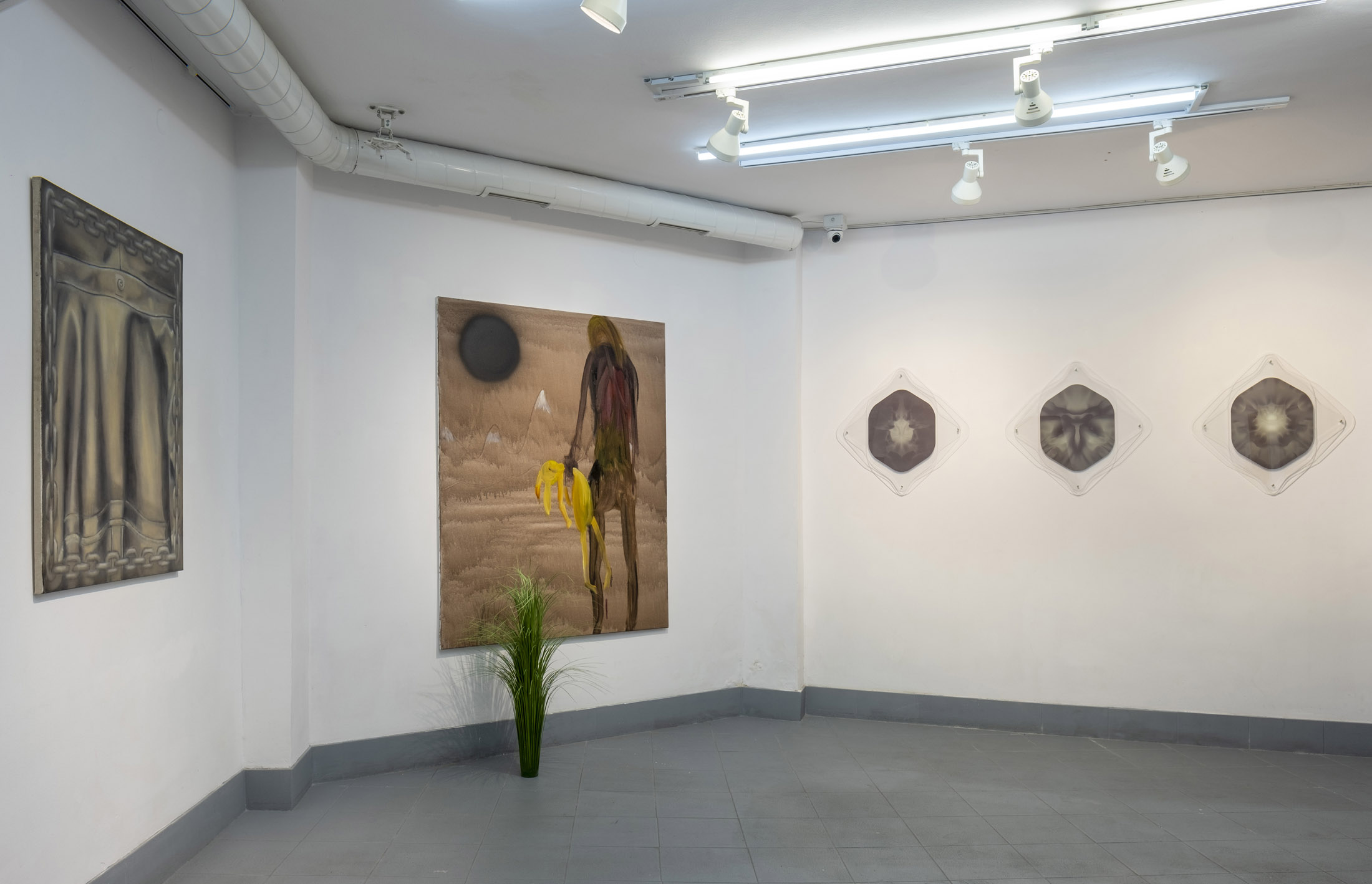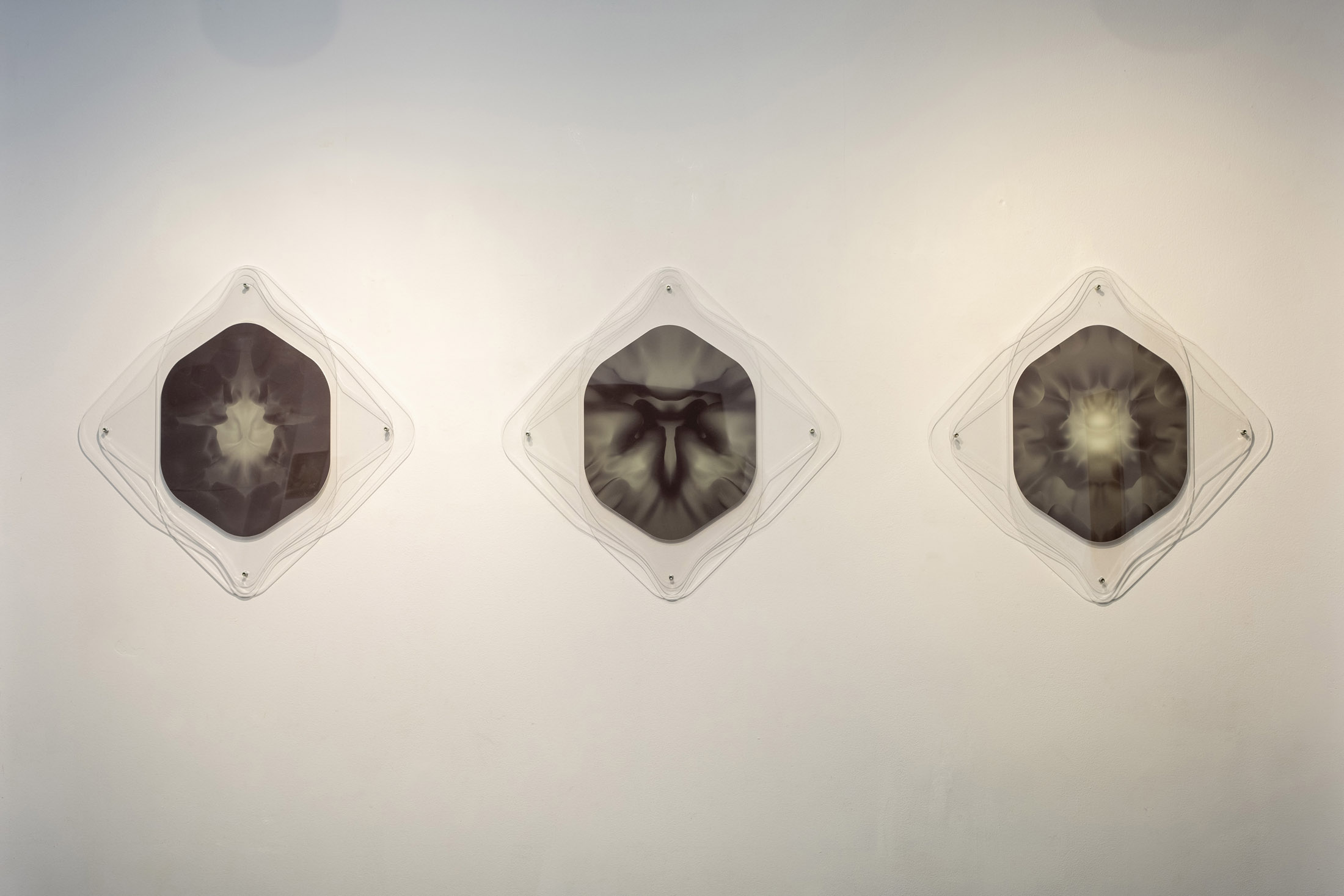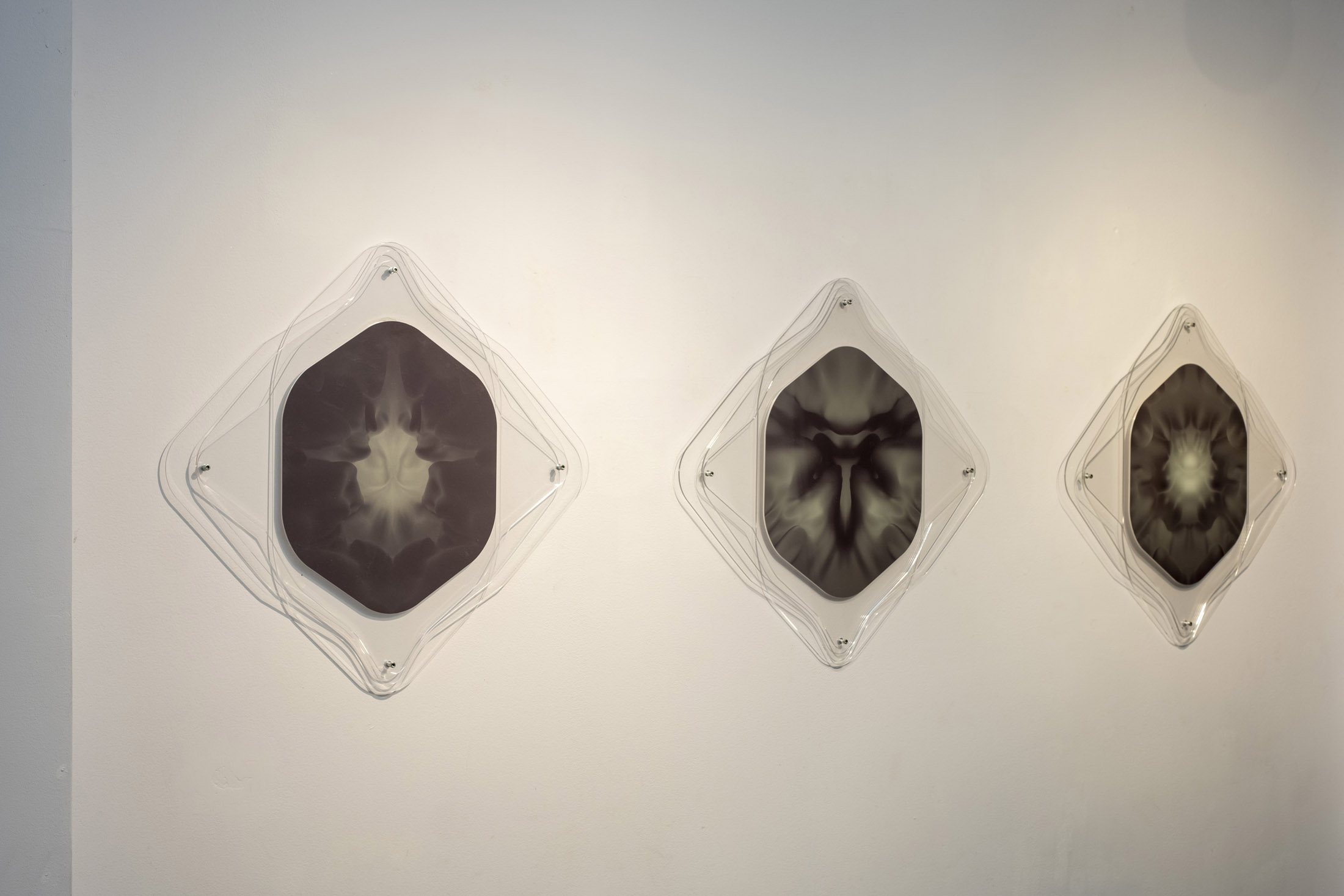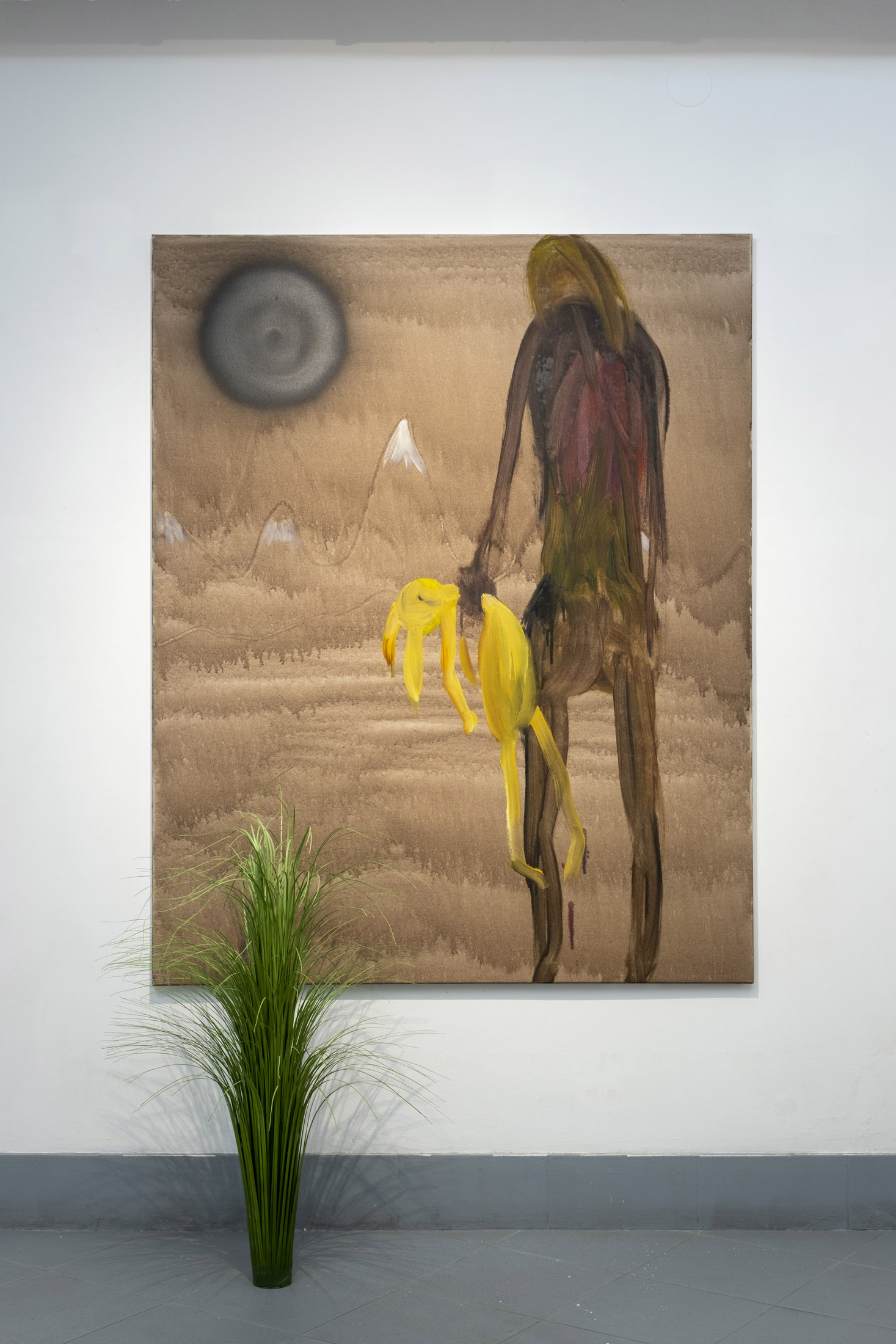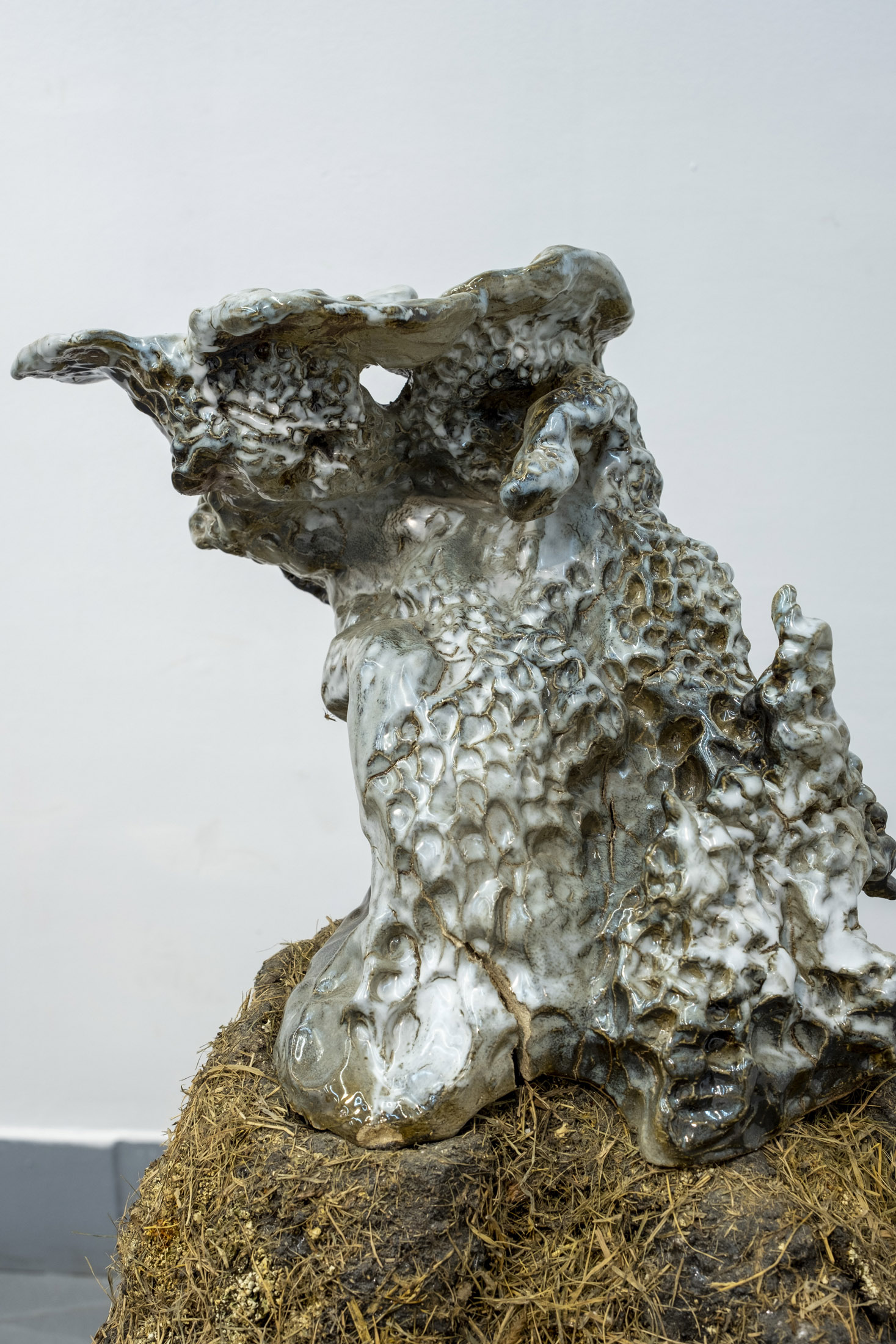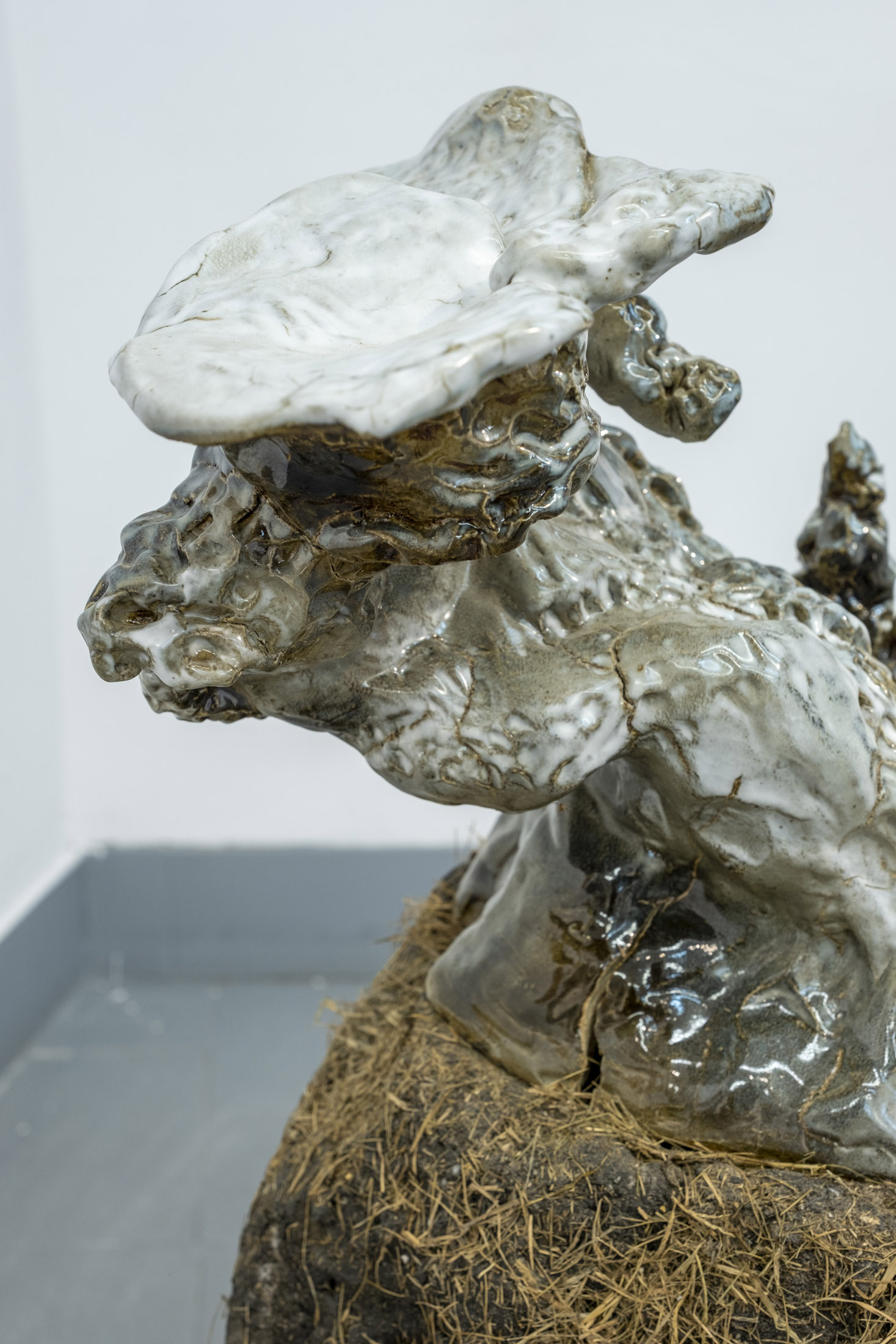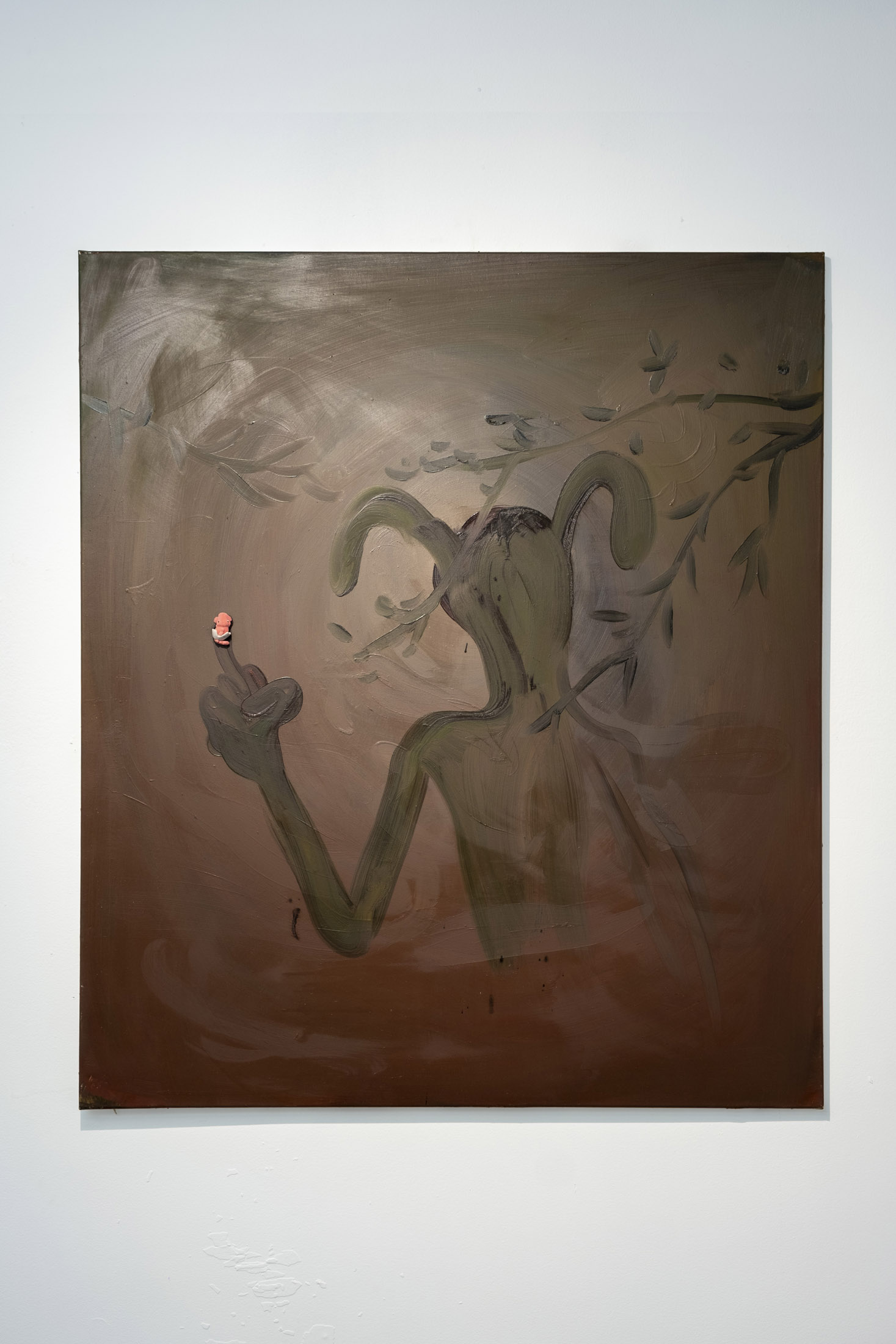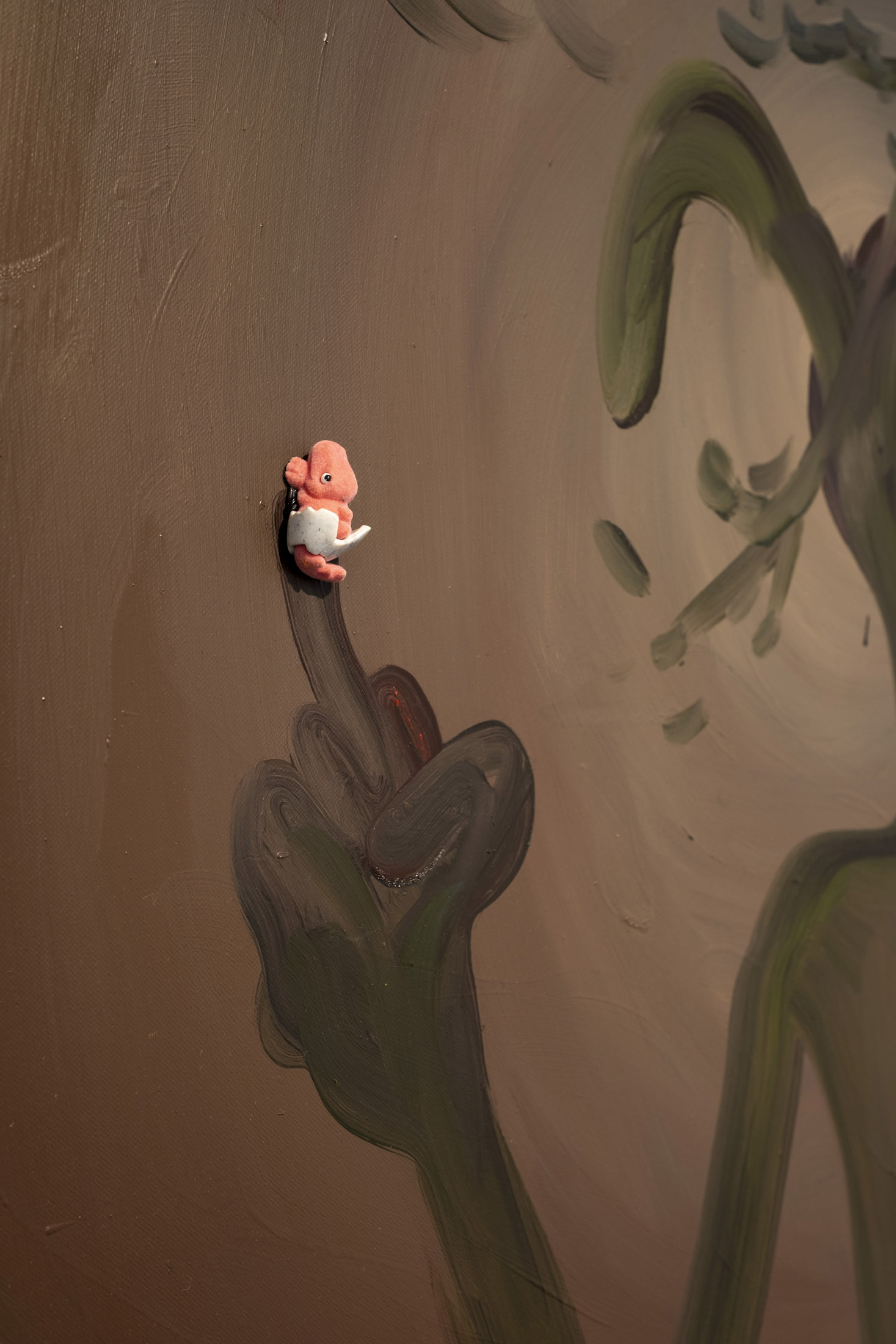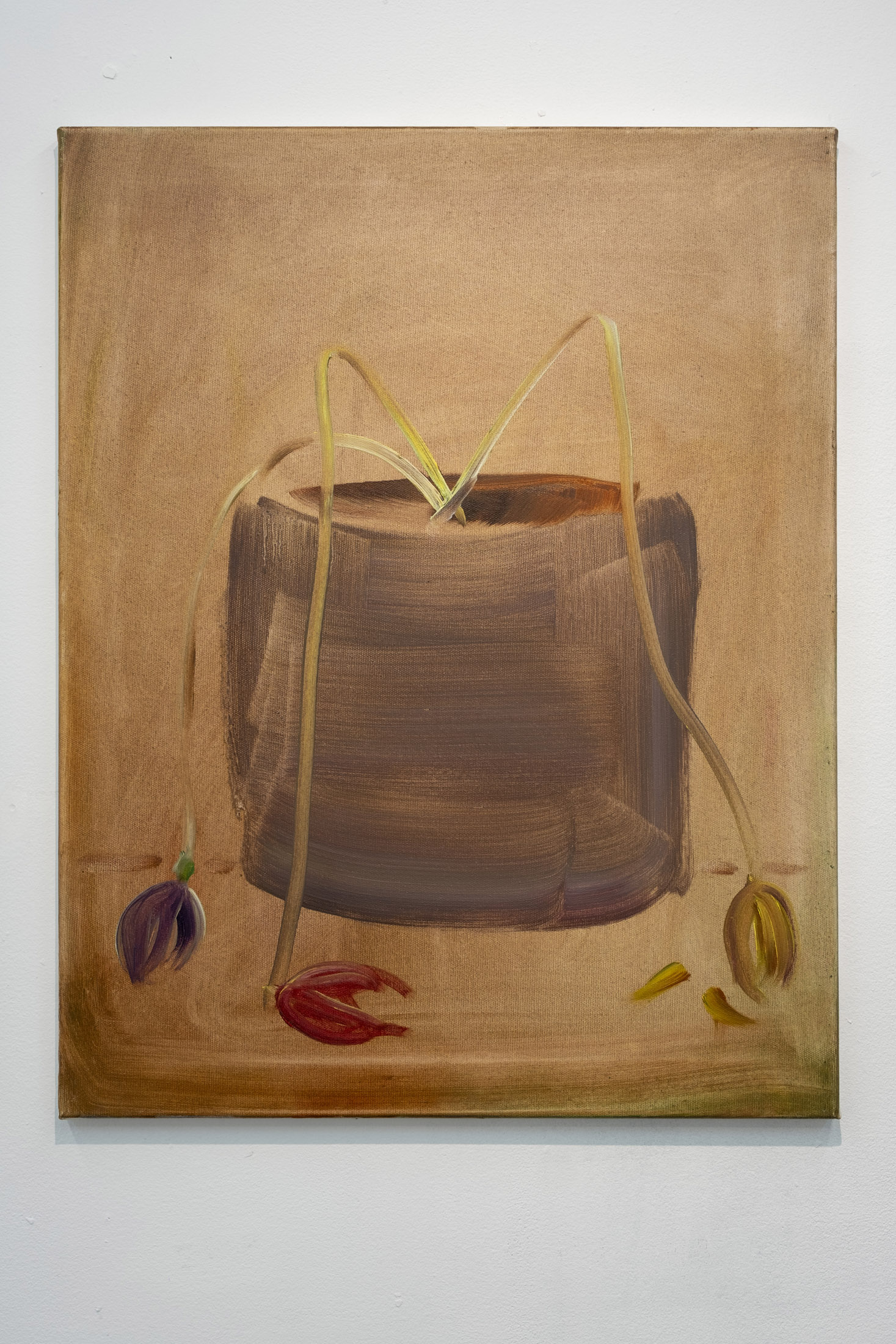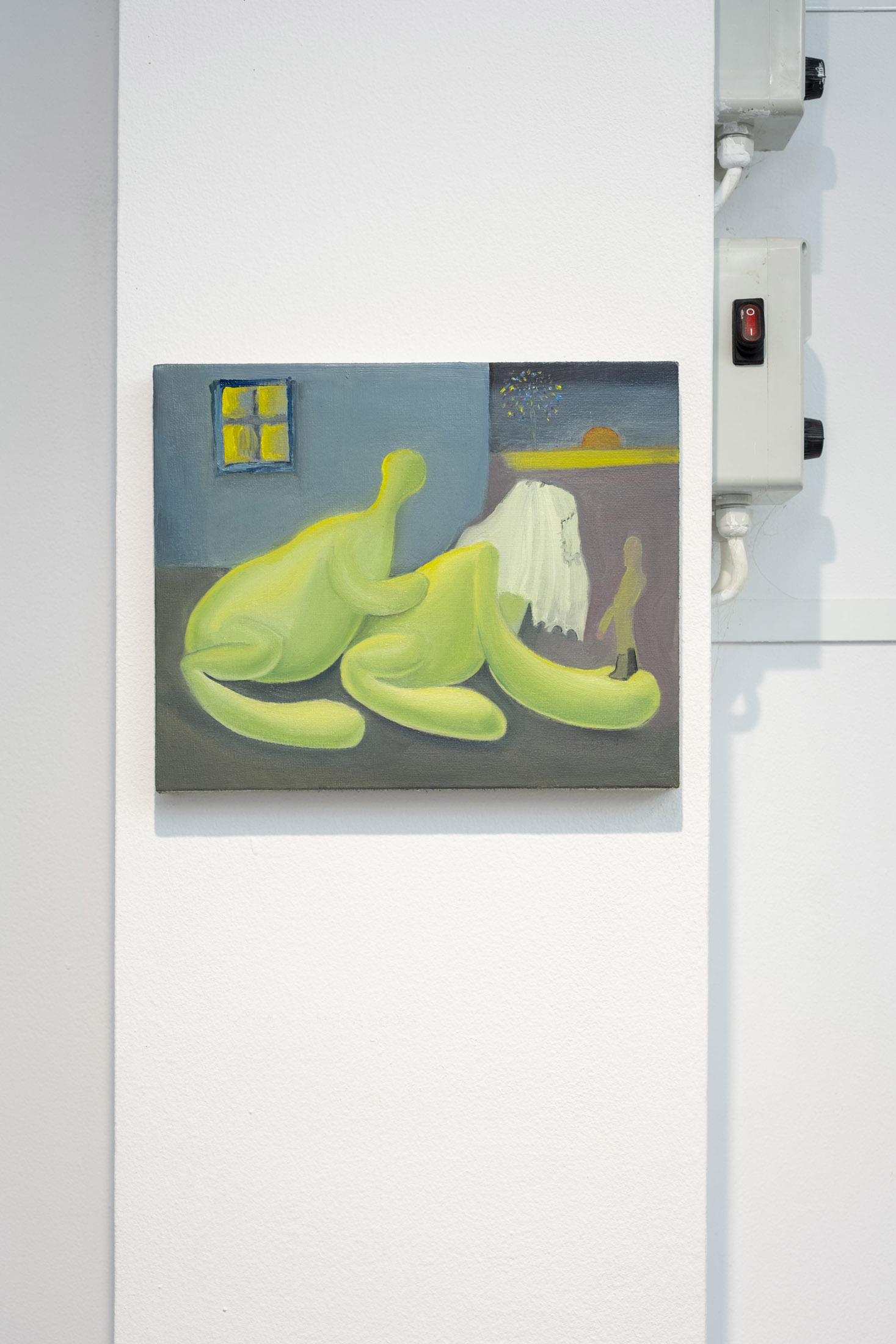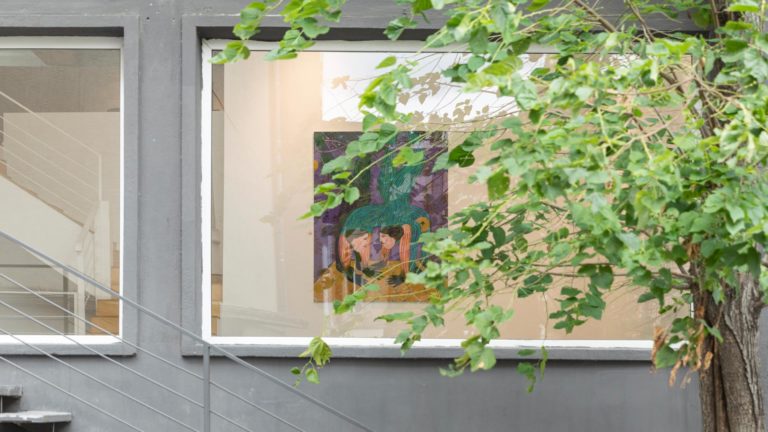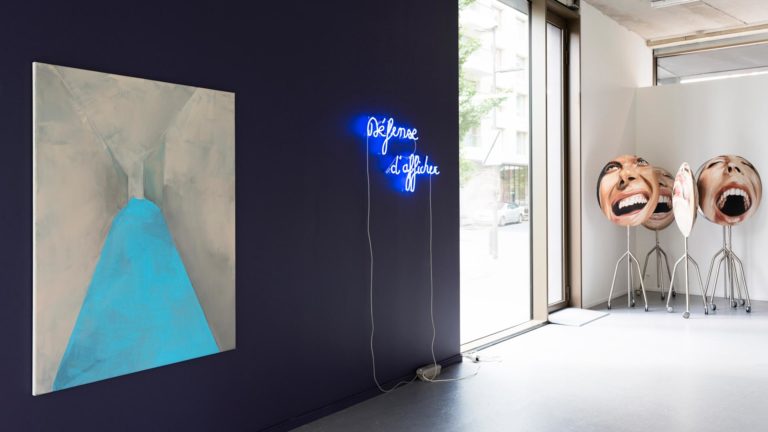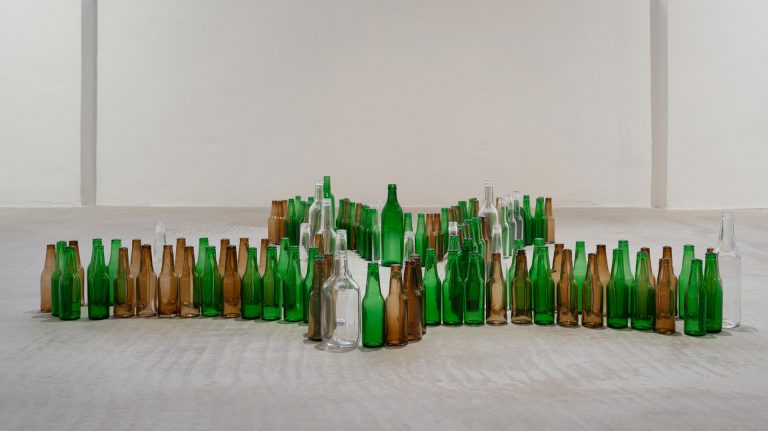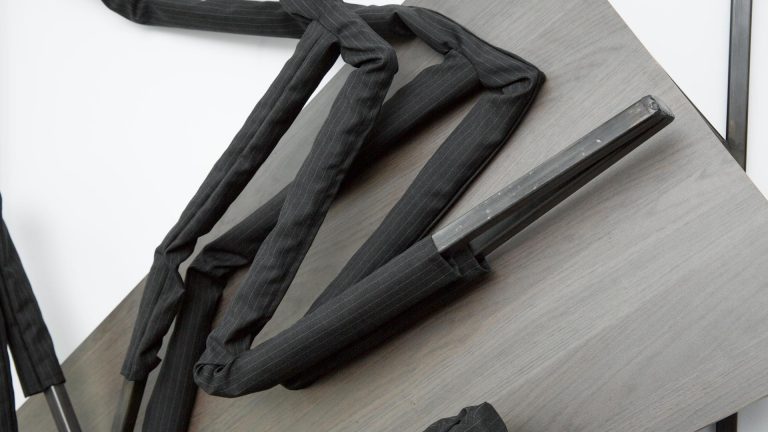Artists: Stanimir Genov, Valio Tchenkov, Lars Nordby, Aaron Roth, Mitch Brezounek, Anton Stoianov, Marina Genova, HR-Stamenov, Martina Vacheva
Exhibition title: Places of Sorrow
Curated by: Domenico de Chirico and Velizar Dimchev
Venue: Gallery Cu29, Plovdiv and underground parking spaces in Kapana, Plovdiv
Date: April 29 – May 28, 2023
Photography: All images copyright of Mihail Novakov, Gallery Cu29 and the artists
Inspired by the mythological novel The Physics of Sorrow by Georgi Gospodinov, considered to be the most prominent representative of post-modernism and the experimental Bulgarian literature, this collective exhibition with an Odyssean touch relies on labyrinthine empathetic processes and aims at experiencing someone else’s stories while reaching back into the past, studying the present, and approaching the future, all at the same time. Its aspiration is to succeed in delineating the sublime, the restless and the fragile, found foating in essence between joys and sorrows, and leaving the time-space coordinates that defne each of these periods.
Having said that, the exhibition Places of Sorrow gives us the opportunity to experience contextually different lives that offer a constantly changing and astonishing perspective. Places of Sorrow offers a multitude of states related to the process of co-experiencing someone else’s mood through side corridors, and labyrinth-like curvilinear paths, because as Gospodinov says, “no labyrinth and no story is ever linear”.
And so, as they look back, live the present and project themselves into the future, the artists who must frst interpret this complex matter and then subjectively put their intentions in order, are: Stanimir Genov, Valio Tchenkov, Lars Nordby, Aaron Roth, Mitch Brezounek, Anton Stoianov, Marina Genova, HR-Stamenov, Martina Vacheva. This mash-up of genres exists between the childish and the realization, giving in to melancholy.
-Text: Domenico de Chirico
The main themes in Stanimir Genov’s work are strongly connected with personal experiences. Focusing on once lived fragments, he tries to experience them again through the artistic process. This approach allows him to interrupt the logical line of thought and thus enter the amazing territories.
Valio Tchenkov strives to create an atmosphere that does not appear threatening, but rather vaguely casual, where the spirits of his everyday companions, human or animal, follow him always and constantly.
Lars Nordby works mainly with art installations, performance and photography, exploring the obsessive human behavior related to identity, ideology and involvement. His works are inspired by elements of the theatrical aesthetics and the melodrama of everyday life in today’s global trends of separatism, nationalism and ideological antagonism. Using theatrics as a tool, Nordby takes on this interdependent, but also disruptive relationship, as a metaphor to explore its power structures and the polarized contradictions in the space between action and thought.
Aaron Roth uses randomly found images, and transforms them through painting, installation, sculpture and photography. All his installation works are somewhere between the ready-made and the assemblage of remnants, in contrast to the classical painting, ironizing everything that is Chalga – a form of Bulgarian folk music, also called ethnomusic or ethno pop. This is where his art is born, between the conspiracy theories and the ceremonial chaos of the advertised luxury goods as objects of desire, nationalist and capitalist myths.
Mitch Brezounek’s art unfolds before our eyes as highly defling, made up of aesthetic chaos and an awareness of the risk of failure. All his works are highly poetic and criticize the absurdities of mankind. Brezounek’s art allows for a discussion of complicated things in a spontaneous and easy way.
Anton Stoianov started his frst series of painted icons in 2006, as soon as he moved from Bulgaria to Germany to study at Berlin’s Universitat der Kunste. In order to reconcile his heritage with his new environment, he uses the techniques of the historical-religious Medieval Byzantine School, interweaving them with the subculture of the Berlin underground. Stoyanov created a series of paintings that defned the spirit of the time, or the Zeitgeist, by adding elements of the contemporary Berlin fetish scene to the classic iconographic images of saints and martyrs. This series offers iconographic images including motifs painted according to Church canon on large wooden blocks and decorated with platinum foil – a technique that Stoyanov learned in Bulgaria as a young artist. With this visual language, used by the ancients in art, Stoianov looks back to the past to infuence the future. In his works, in an attempt to rewrite the history that would give birth to the new martyrs – saviors of our time, he combines biblical fgures and narratives with the microscopic world of insects, which are a symbol of the fragility of our ecosystem.
Marina Genova works primarily with digital media, with an emphasis on the exploration of the boundary between the real and the virtual, as well as between the past and the present. Marina uses modern technologies to create a “third space” where both fction and historical facts dominate. This exploration of the space between past and future, and between real and virtual, reveals a new interpretation of our current place in the world. Pushing the limits of technology, Genova offers a unique experience in the computerized realm that blurs the lines between real and digital.
HR-Stamenov’s artistic work, from video materials to photographic documents, consists of documenting works of art based on historical events, scientifc reports and paranormal phenomena. On the occasion of this exhibition, Stamenov presents his work The Phenomenon of W24° 5859.43 N42° 0755.29, a project created together with the DLQ collective: legendary as The Enterprise, mysterious as Kubrick’s monolithic block, spectral as The Flying Dutchman a convoy between time and space, in which the video art ventures with unprecedented speed and depth. This work tells that on 29 Sept 1999 between 16:08:56 – 16:09:13 at coordinates W24°58’59,43” N42°07’55,29”, entering a space-time tunnel caused by a Light Hole, regional train of BDZ number PV16199 has suddenly disappeared with 15 passengers, an engine driver, two ticket inspectors and a policeman on board.
Experts from the Research Institute believe that from the moment of disappearance the train might have the capability of unexpectedly reappearing in certain places, risking causing catastrophes and destruction. Following its self-contained space-time trajectory, the train needs neither rails nor electricity. In this swing of time dominated by a chaotic chronotope, 10 years later the video presented here documents the passing of the ghost train in the center of the Italian city of Savona, right between the walls of the Palazzo Comunale.
We have no choice but to watch the video of its spontaneous, meteoric, destructive appearance, and who knows, maybe someone would make us get on this imaginary multidimensional locomotive that would throw us into a quantum jump into hyperspace, following the principles of these secret Places of Sorrow.
Martina Vacheva’s sculpture “Become a stoned mushroom” part of the “MUD” series (2018) is inspired from a legend by mushroom-shaped rock formations near by Rhodope heights (South Bulgaria). According to the legend, four sisters after their death were turned to stone there.
The sculpting shapes are reminding a limestone formations from stalactite cave such natural phenomena which have always spurred our imagination and attest to our need to tell stories. The cave reference is also a symbol of the unconscious, a place where stories are formed before they reach the surface in the form of language.
The choice of natural materials such as ceramic, cinder, lichens, mosses, dried grass is interest in the transitions and transformations in human nature and the psyche, which feature so vividly in fairy tales and myths, as well as in uncanniness and danger, which are at once captured and preserved in the stories. The materials and the symbol of “mushroom” are chthonic features those related to the earth, death, and the underworld and rebirth.
Marina Genova, Puppy, 2023, 40 x 18 x 10cm, glazed ceramics, resin, acryl
Marina Genova, Puppy, 2023, 40 x 18 x 10cm, glazed ceramics, resin, acryl
Lars Nordby, Come tole with me, 2023, Dimensions variable / Recontextualized art installation done at ICA in Sofia (2022), originally titled Restaging Parallax
Lars Nordby, Come tole with me, 2023, Dimensions variable / Recontextualized art installation done at ICA in Sofia (2022), originally titled Restaging Parallax
Lars Nordby, Come tole with me, 2023, Dimensions variable / Recontextualized art installation done at ICA in Sofia (2022), originally titled Restaging Parallax
HR-Stamenov, Ghost train, 1999-2009, ongoing project, video installation, loop
HR-Stamenov, Ghost train, 1999-2009, ongoing project, video installation, loop
Places of Sorrow, 2023, exhibition view, parking space, Kapana
Places of Sorrow, 2023, exhibition view, parking space, Kapana
Anton Stoianov, Neoptera, 2021, 60 x 80 cm, wood panel, gouache and platinum
Anton Stoianov, Anax Imperator, 2020, 40 x 50 cm, wood panel, gouache and platinum
Anton Stoianov, Apo, 2023, 30 x 40 cm, wood panel, gouache and platinum
Lars Nordby, Come tole with me, 2023, Dimensions variable / Recontextualized art installation done at ICA in Sofia (2022), originally titled Restaging Parallax
Lars Nordby, Come tole with me, 2023, Dimensions variable / Recontextualized art installation done at ICA in Sofia (2022), originally titled Restaging Parallax
HR-Stamenov, Ghost train, 1999-2009, ongoing project, video installation, loop
HR-Stamenov, Ghost train, 1999-2009, ongoing project, video installation, loop
HR-Stamenov, Ghost train, 1999-2009, ongoing project, video installation, loop
Lars Nordby, Come tole with me, 2023, Dimensions variable / Recontextualized art installation done at ICA in Sofia (2022), originally titled Restaging Parallax
Places of Sorrow, 2023, exhibition view, parking space, Kapana
Places of Sorrow, 2023, exhibition view, parking space, Kapana
Lars Nordby, Laugh, 2023, 80 x 10 x 45 cm / interval automated light-box
Lars Nordby, Applause, 2023, 80 x 10 x 45 cm / interval automated light-box
Lars Nordby, Applause, 2023, 80 x 10 x 45 cm / interval automated light-box
Marina Genova, Puppy, 2023, 40 x 18 x 10cm, glazed ceramics, resin, acryl
Marina Genova, Puppy, 2023, 40 x 18 x 10cm, glazed ceramics, resin, acryl
Marina Genova, Puppy, 2023, 40 x 18 x 10cm, glazed ceramics, resin, acryl
Marina Genova, Puppy, 2023, 40 x 18 x 10cm, glazed ceramics, resin, acryl
Marina Genova, Puppy, 2023, 40 x 18 x 10cm, glazed ceramics, resin, acryl
Places of Sorrow, 2023, exhibition view, parking space, Kapana
Places of Sorrow, 2023, exhibition view, parking space, Kapana
Places of Sorrow, 2023, exhibition view, parking space, Kapana
Places of Sorrow, 2023, exhibition view, parking space, Kapana
Places of Sorrow, 2023, exhibition view, parking space, Kapana
Places of Sorrow, 2023, exhibition view, parking space, Kapana
Places of Sorrow, 2023, exhibition view, parking space, Kapana
Places of Sorrow, 2023, exhibition view, parking space, Kapana
Aaron Roth, Mercedes interior, 2021, 180 x 150 cm, oil on canvas
Aaron Roth, Casino slot machines night/day, 2023, 180 x 130 cm, oil on canvas inserted in upholstery with faux crocodile leather
Aaron Roth, The way that we came is the way that we’ll go, 2021, 70 x 25 x 17 cm, illuminated metal framed sing, fluorescent tube, image of a Mercedes hears, 35mm photograph printed on plexiglass
Places of Sorrow, 2023, exhibition view, parking space, Kapana
Mitch Brezounek, Fairy, 2023, 130 x 56 cm, wood, metal, foam, plasticine, horse hair, wax, textile
Mitch Brezounek, Fairy, 2023, 130 x 56 cm, wood, metal, foam, plasticine, horse hair, wax, textile
Mitch Brezounek, Imago, 2023, 45 x 30 cm, wood, wax, textile, foam, horsehair
Mitch Brezounek, Imago, 2023, 45 x 30 cm, wood, wax, textile, foam, horsehair
Mitch Brezounek, Red Noise, 2023, 60 x 50 cm, acrylic on canvas and wood frame
Places of Sorrow, 2023, exhibition view, Gallery Cu29, Plovdiv
Places of Sorrow, 2023, exhibition view, Gallery Cu29, Plovdiv
Places of Sorrow, 2023, exhibition view, Gallery Cu29, Plovdiv
Places of Sorrow, 2023, exhibition view, Gallery Cu29, Plovdiv
Places of Sorrow, 2023, exhibition view, Gallery Cu29, Plovdiv
Places of Sorrow, 2023, exhibition view, Gallery Cu29, Plovdiv
Places of Sorrow, 2023, exhibition view, Gallery Cu29, Plovdiv
Places of Sorrow, 2023, exhibition view, Gallery Cu29, Plovdiv
Stanimir Genov, Tears 01, 2023, 60 x 60 cm, plexiglass, print
Stanimir Genov, Tears 03, 2023, 60 x 60 cm, plexiglass, print
Valio Tchenkov, Offside Landscape, 2017, 150 x 200 cm oil on canvas, plastic brush
Martina Vacheva, Become a stoned mushroom, 2018, 104 х 50 х 56cm, glaze ceramic, clay, styrofoam, cinder, lichens, mosses, dried grass, epoxy resin
Martina Vacheva, Become a stoned mushroom, 2018, 104 х 50 х 56cm, glaze ceramic, clay, styrofoam, cinder, lichens, mosses, dried grass, epoxy resin
Martina Vacheva, Become a stoned mushroom, 2018, 104 х 50 х 56cm, glaze ceramic, clay, styrofoam, cinder, lichens, mosses, dried grass, epoxy resin
Martina Vacheva, Become a stoned mushroom, 2018, 104 х 50 х 56cm, glaze ceramic, clay, styrofoam, cinder, lichens, mosses, dried grass, epoxy resin
Martina Vacheva, Become a stoned mushroom, 2018, 104 х 50 х 56cm, glaze ceramic, clay, styrofoam, cinder, lichens, mosses, dried grass, epoxy resin
Aaron Roth, pierre cardin, 2022, 100 cm x 80 cm, oil on canvas
Valio Tchenkov, Thinking of A.K., 2018, 115 x 100 cm, Oil and toy on canvas
Valio Tchenkov, Thinking of A.K., 2018, 115 x 100 cm, Oil and toy on canvas
Valio Tchenkov, Thinking of A.K., 2018, 115 x 100 cm, Oil and toy on canvas
Valio Tchenkov, Untitled, 2022, 70 x 60 cm, Oil on canvas
Mitch Brezounek, Sex frogs, 2023, 30 x 20 cm, oil on canvas


